June 18, 2007
Gallery TPW presents
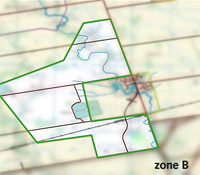
Dubious Views
Dubious Views: Questioning Institutional Representations in Tourism and Cartography :: Curators: Michelle Kasprzak, Michael Alstad, Shawn Micallef :: A bilingual online exhibition produced by Gallery TPW and funded by the Virtual Museums of Canada.
Every time you open your eyes, a hundred different sources vie for your attention. This spectacle - the cacophonous accumulation of images superimposed over the "real" world - is built by everything from advertisements to entertainment to government. This institutional view of the world can come to stand in for and suppress any other visions or versions that might be out there.
The artists discussed in Dubious Views address the role of the "institution" in terms of its effect on the understanding of place. It is examined in relationship to the tourism industry, and in the context of mapmaking and geography. In both cases, the artists involved look at and play with creating alternatives to the institutional view, and attempt to challenge its singularity, its authority, and its monolithic profile.
Artists include: David Rokeby, Surveillance Camera Players, Michelle Teran, Proboscis, Sylvia Grace Borda, Janet Cardiff, Eugene Atget, Nikki S. Lee, Charles Marville, Roger Minick, [murmur], N.E. Thing Co., Shelley Niro, Louise Noguchi, Mitch Robertson, Ed Ruscha, Camille Turner, Jin-me Yoon, and more.
Posted by jo at 11:50 AM | Comments (0)
June 14, 2007
Conor McGarrigle's
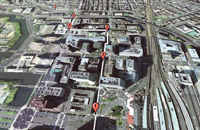
Joyce Walks
Joyce Walks a new project by Conor McGarrigle: Because somewhere, sometimes it's always Bloomsday. Every June 16th in Dublin Joyce enthusiasts celebrate Bloomsday with re-enactments of events from Ulysses. Unfortunately not everyone can be in Dublin for that day but why should that stop you celebrating Bloomsday where you want when you want. So as Bloomsday approaches we announce Joyce Walks a web 2.0 service which will let you map routes from Ulysses to any city in the world so that Bloomsday can be celebrated in any place at any time.
Joyce Walks is a psychogeographical tool which generates walking maps based on routes from James Joyce's Ulysses in any city in the world using Google Maps. The system prints maps to be used as the basis of walks exploring the city of your choice and generates mashups using your pictures and videos documenting these walks to share with other users.
Inspired by the Situationist idea of the Derive Joyce Walks seeks to provide the walker a means of exploring the urban environment which is unique, truly random but removed from a reliance on chance. Although based on a fixed route each map generated is unique as it is based on an individual selection by the user of the center point of their chosen city thus every map provides the walker a means of exploring the urban environment which although based on routes which are predetermined according to a strict adherence to a text is individual to them. Of course removing these routes from Dublin removes specific spatial relevance but they still retain an aura of association which creates a link between the locations and Joycean Dublin.
Joyce Walks saves every map generated to a database. These walks, in addition to being specific to their creator, form part of a continuum where each specific walk performed by any user of the system is added to an searchable archive of unique performative walks from around the world. This archive over time will become a tool to explore and view many unique walks in many cities around the world creating a veritable web 2.0 psychogeographical rough guide.
Requirements: Firefox or Safari browser , in this beta version Internet Explorer is not supported, support for IE will be added shortly. Due to copyright issues between Google and the British Ordnance Survey cities in the UK and Northern Ireland are not searchable, we are working to find a solution for this.
Posted by jo at 06:03 PM | Comments (0)
April 02, 2007
Turbulence Commission:

Urban Attractors, Private Distractors
Turbulence Commission: Urban Attractors, Private Distractors by Angie Eng in collaboration with Rich Streitmatter-Tran and a collective of student interns in New York and Ho Chi Minh City.
"Urban Attractors and Private Distractors" is a vlog project about privacy in public space in Eastern culture. It compares the results of dérives (French for "drift," dérive was defined by the Situationists as the "technique of locomotion without a goal") in Ho Chi Minh and New York City. The collective will address questions such as: How is a city constructed in a culture where the inhabitants have little experience of a private physical space? Do they adapt more readily to cyberspace which is both private / public simultaneously? How do Westerners reclaim their 'public space'? Organized dérives in both cities will commence at the most public of spaces--the town square. Participants will submit videos as urban indicators of private and/or public to the vlog until the workshop meetings in June 2007. Angie Eng, the project director, will continue vlogging until the commencement of the physical installation in Fall 2007.
"Urban Attractors, Private Distractors" is a 2007 commission of New Radio and Performing Arts, Inc., (aka Ether-Ore) for its Turbulence web site. It was made possible with funding from the Jerome Foundation.
BIOGRAPHY
Angie Eng is a media artist who works in video, installation, web-based and video performance. In 1993 she moved to New York City to pursue her career in media arts. She co-founded The Poool (1996-1999), a live video performance group, with Nancy Meli Walker and Benton Bainbridge. Her work has been performed and exhibited at the Whitney Museum of American Art at Philip Morris, Lincoln Center Video Festival, The Kitchen, New Museum of Contemporary Art, Rensselaer Polytechnic Institute, Experimental Intermedia, and Roulette Mixology Festivals. Eng’s videos have been included in digital art festivals in local and international venues in Cuba, Greece, Japan, Germany, Former Yugoslavia, Switzerland and Canada. She has received numerous grants and commissions: New Radio and Performing Arts, Inc., Harvestworks Residency, Art In General, Lower Manhattan Cultural Council, New York State Council on the Arts, mediaThe Foundation, the Jerome Foundation and the Experimental TV Center. She was recently awarded an Eyebeam residency to develop the installation component of "Urban Attractors, Private Distractors."
Posted by jo at 09:35 AM | Comments (0)
January 09, 2007
Robert Ladislas Derr

Chance: Breckenridge
(Breckenridge, CO) Robert Ladislas Derr will perform Chance: Breckenridge, a psychogeographical walk performance (resulting in an exhibition) through the streets of Breckenridge for the Tin Shop Guest Artist Program on January 25, 2007 starting outside the Tin Shop, 117 E Washington Avenue at noon. The gallery viewers at the Tin Shop will determine the direction of his walk performance through the streets based upon the roll of dice at the “meet the artist” reception on January 24 from 4 pm to 6 pm. The dice indicates that he move forward, backward, right, left, spin, or stand in place. He will accept thirty dice rolls then proceed on his walk accordingly on January 25. When spin or stand in place are the command, he will complete each for one minute. The directional commands will take him to the next intersection, as he continues the walk for approximately forty-five minutes.
Just as in past performances, he will wear the mirrored suit to allow his presence on the street to be real and illusionary, and have four video cameras attached to his person, recording simultaneously the front, rear, and side views of his journey. Using the city as a fluid canvas, Derr will move through the streets in silence capturing the ephemeral characters that construct the ambiance of place and time. With the cameras attached to his body, the arrhythmic quality of the videos provides a delusive appearance to the captured scenes. The videos from the performance will be on view at the Tin Shop from January 28 to February 5, 2007.
Accentuating the dichotomy of the mirrored suit, there will be two walls of mirrors that create the cartography of the performance in the gallery. Initially, each of the six commands will be represented by thirty columns of six mirrors – thirty columns for the thirty dice rolls. After the viewers’ dice rolls are recorded, the number of mirrors that corresponds to the command will be removed from the column that corresponds to the sequence of dice rolls and hung on an opposing wall. One wall creates the cartography of the walk in the positive and the other in the negative. When the gallery viewer stands between the two walls of mirrors that have an oscillating presence of real / illusionary, physical / metaphysical, inside / outside, and visible / invisible, the dichotomy of the cartography of the performance is highlighted.
In his psychogeographical walk performances, Derr is interested in the chance encounter between pedestrians and himself. Through his self-induced spectacle walk performances, Derr raises awareness of the individual in society. Each individual plays an important role in creating the fabric of place. However in Chance: Breckenridge not only is interface with pedestrians emphasized, but also interaction with the gallery viewers is crucial for his progression. Subverting the traditional social structure of the gallery system that prefers the viewers to be quiet observers, he relies on the viewers to determine the direction of his walk.
Moving through the streets in Breckenridge by rational and irrational means, walking in silence through the crowd, letting his cameras record, Derr will capture an unedited glimpse of an unfolding drama. Just as Henri Cartier-Bresson photographed his decisive moments, Derr’s video cameras will record many decisive moments in the framework of linear time, capturing the banality of existence between these moments. The videos will present a visual record of the homogeneity of daily life, while none of daily experiences are completely uniform, the geographical environment renders them as a collective. In this infinite game of chance that Derr takes to cities throughout the world, the viewer in the gallery and the pedestrian on the street is affected by this unconventional means of video production that documents the particular time that Derr was there.
Each performance of Chance provides a contemporary document of each place using detournement to undermine conventional methods of walking through a city. Expanding on Guy Debord’s concept of detournement, Chance creates cartographies of each city by means of chance rather than by some rational directive method. Together with videos and mirrors, Derr demonstrates this detourned method of map making. Combined, the two mediums illustrate the city as a place for potential discovery rather than structured conformity. Considering Debord’s unconventional and influential map of Paris titled, The Naked City, 1957, Derr’s Chance functions within a similar discourse by using today’s technology to remap the city with non-linear methods.
The Tin Shop will be open to the public noon to 5 pm Thursday through Sunday. Robert Ladislas Derr will be a guest January 23 to February 6, 2007. For more information: http://www.townofbreckenridge.com
Articles about some of Derr’s psychogeographical walk performances:
Posted by jo at 01:18 PM | Comments (0)
December 21, 2006
rhizomes.13 fall 2006

Special Issue: Drifts
"[1] Confronted with spaces more than ever gridded and pre-arranged, mapped from the google universes to the nano-th degree, and already (over) saturated with the intentions of others, the contributors in this issue take up the general theme of drifts and drifting. The responses to our initial call range widely across genres (scholarly essays, fiction, nonfiction, film, accounts of performances), terrains (urban, rural, psychological, virtual), structures of feeling, and modes of locomotion from the pedestrian to the spectacular (a semi-truck). Several essays deliberately follow in the steps of the Situationist psychogeographers, such as Phil Smith and Clive Austin’s playful dérive around Exeter, England, or Jim Miller’s more sober-minded drift in downtown San Diego. Others chart a different trajectory as in Dianne Chisholm’s account of Ellen Meloy’s nomad raids on the nuclear-wasted desert or Casey Clabough's elegiac retracing of the Warrior’s Path." From Introductory Drift by Ellen E. Berry and Craig Saper, rhizomes.13 fall 2006
In this issue: Place and the Electrate Situation by William Tilson and John Craig Freeman :: Transfers: Portrait of a City by Matt Roberts and Kristin Powers :: A Case for Boston as a Liquid not a Solid by Catherine D’Ignazio.
Posted by jo at 06:42 PM | Comments (0)
November 20, 2006
Glowlab
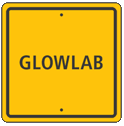
Issue 11
Welcome to Glowlab Issue 11! The projects in this issue examine the presence of surveillance within public space, and the ways in which ubiquitous technologies, such as electronic tags, global positioning systems, SMS messaging, and other locative media are informing the ways in which we interact within urban environments. These artists utilize these technologies to create mobile orchestras, jam turnstiles, observe the observers, and put the means and the media of production into the hands of ordinary citizens. This issue also includes independent curator Anuradha Vikram's review of Psychogeography by Merlin Coverly.
Transparent City: The ethics and aesthetics of mass-surveillance technologies by Derek Lomas :: Mobile phone carriers track our location and keep a record of everywhere that we have been. TRANSPARENT CITY is a prototype surveillance interface demonstrating how widespread mobile phone technology could be transformed into an apparatus for massive governmental control.
The Warbike and Wardriving: Geeks Don't Know it's Psychogeography by David McCallum :: The Warbike is a mobile, interactive artwork that sonifies WiFi networks during a bike ride. This article describes the process of creating the system, and touches on the links between psychogeography and wardriving.
Inner city locative media: The Media Portrait of the Liberties project by Valentina Nisi :: The Media Portrait of the Liberties is a modular collection of anecdotal stories drawn from a disadvantaged Dublin inner city neighbourhood called the Liberties. The narratives are displayed as short video clips on a location-aware handheld computer.
TXTual Healing by Paul Notzold :: TXTual Healing is an interactive project that enables members of the public to interact with large speech bubbles that are projected onto flat surfaces, such as the facades of public buildings, using SMS messaging.
arphield recordings by Paula Roush :: Arphield Recordings is a project documenting impromptu arphid sound performances produced by people scanning their oysters cards in their daily routines of accessing London tube stations.
Fête Mobile and Inflatable Art by Marc Tuters, Fête Mobile :: Movable Feast/ Fête Mobile is a 6-meter blimp equipped with surveillance and communications capabilities that enables participants to remotely view their surroundings and exchange media files through a wireless file server. In his article, we discuss the development of the project.
Book Review: Psychogeography by Merlin Coverley by Anuradha Vikram :: Psychogeography is a primer on the practice and its precedents, inspired by the neo-psychogeographic revival in London over the past two decades, and focusing specifically on the theoretical lineage of contemporary British writers.
Glowlab is an artist-run production and publishing lab engaging urban public space as the medium for contemporary art and technology projects. We track emerging approaches to psychogeography, the exploration of the physical and psychological landscape of cities. Our annual Conflux festival, exhibitions, events and our bi-monthly web-based magazine support a network of artists, researchers and technologists around the world.
Posted by jo at 01:40 PM | Comments (0)
November 18, 2006
Franck Ancel
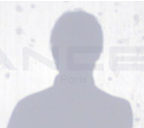
Tuut: Utopia of Theater
"Studying the terrain, the litterateurs believe they have established the existence of a major psycho-geographic crossroads — with Ledoux's Rotonde de la Villette at the centre – which can be described as a unity…" - the journal Les Lèvres nues, November 1956, Paris.
Mobile_Wireless_Digitale, for the bicentenary of the death of the utopian architect Claude Nicolas Ledoux in Paris, faced with the extension of the Cité des Sciences et de la Musique. I am no longer drafting a utopian performance which could have involved an immersive projection (cf. estimate drawn up with the UTRAM company) within Ledoux's Rotonde, and have been made possible by means of an inflatable dome (cf. study by another company), as conceived by me since 2001.
In contrast with some of the anticipated utilitarian hijackings aimed at establishing a modicum of social aesthetics on the square that is dedicated to the battle of Stalingrad in Paris, my idea involved a light and sound projection at the entrance to this capital: issues not only of physical fluidity but also fluidity of data. Thus, this space that traces the old boundaries closing in on the city, would be transformed by opening up the city, at a time when a dark globalisation is being prepared for us by some of the uses to which technology is being put.
I therefore propose an open-access 3gp stream broadcast from GPS co-ordinates N 48°53.365' E 002°22.555' to video receivers at this address: rtsp://217.71.210.164/ancel/19 , to other portables and on the Internet, on 19 November 2006 between 19:00 and 20:00 (Paris GMT). The 3D animation of this presentation has been created in association with Bryan Bey. It transfigures my Black Time epoch, for this action is primarily the echo of a manifesto for a Pari(s) lancé dans un lyrisme électronique (‘Paris (bet) cast in an electronic lyricism'), between active memory and the virtual future. - Franck Ancel
Posted by jo at 11:49 AM | Comments (0)
October 19, 2006
Net_Dérive
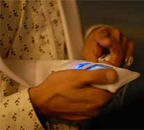
The City as Instrument
Net_Dérive, by Atau Tanaka and Petra Gemeinboeck with the collaboration of Ali Momeni, is a location sensitive mobile media art piece that calls for an exchange between participants in the gallery and participants in the streets. Deployed on advanced mobile phones, the work seeks to create a kind of musical instrument, thinking of the city-as-instrument.
Participants are given a kind of scarf with a mobile phone in each end and off they go to explore the neighborhood. One of the phones takes pictures every 20 secs and collects sounds, the other talks to the GPS (also in the scarf) and to the server inside the gallery space. On a radar they can see themselves pictured as dots but also the images they're taking. The sounds and pictures collected in the streets are sampled and mapped to a 3D city map in the gallery. As users are walking they can hear some voice instructions through a pair of headphones. Those comments suggest paths to follow or turns to make, they are generated and heard in a musical fashion. The voice instructions are inspired by the old Situationist games and theory of the Dérive - now brought into the digital and mobile spheres. As the user chooses to heed or ignore these instructions, a trace of his/her path is carved out in the city.
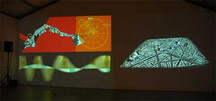
The engine then generates an audiovisual amalgam based on this information, and feeds it back as a live stream to each mobile client. The simultaneity, history, and memory of the various users’ paths and images become an abstract narrative that is summed together and projected in the gallery space. A feedback mechanism is created as users’ actions generate the collective narrative that in turn directs them.
Presented in Paris during the IntensiveScience exhibition of Sony CSL Paris, 6, 7-october 2006
Photos by Walter Kim. Images and information courtesy of Atau Tanaka.
Related: Sonic City, a wearable piece that enables people to compose music in real time by walking through the city; headphones that turn urban noise into music. Atau Tanaka's talk at Futuresonic; Pixel bondage on rice paper. [blogged by Regine on we-make-money-not-art]
Posted by jo at 08:38 AM | Comments (0)
October 05, 2006
Greenwich Emotion Map
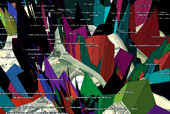
Bio Mapping
Developed by Artist Christian Nold, the BioMapping project is set up as a series of participatory workshops that invite people to borrow a Bio Mapping device and go for a walk. The device measures the wearer's Galvanic Skin Response (GSR), which is an indicator of emotional arousal in conjunction with their geographical location. The resulting maps encourage personal reflection on the complex relationship between us, our environment and our fellow citizens. By sharing this information we can construct maps that visualise where we as a community feel stressed and excited.
Posted by michelle at 08:31 PM | Comments (0)
September 27, 2006
GLOWLAB.10

september :: october 2006
Welcome to Issue 10, featuring projects from Conflux 2006 that investigate social and political spaces within Brooklyn through performance-based intervention, mobile broadcast, historic reenactment and collaborative exploration.
It was a pleasure seeing many familiar and new faces at Conflux this year. The festival took place September 14–17 in Williamsburg and featured projects by over 80 artists from around the world who offered guided and un-guided tours [some of them smelly], street games, workshops, mobile broadcasts, multimedia presentations and more. Despite a little rain, we built and planted and cycled and recycled. Needless to say, the neighborhood was thoroughly explored. More photos and posts are on our site here and on Flickr here. If you have Conflux photos, post 'em and tag 'em: conflux2006.
We're jumping straight back into planning for Conflux 2007 so keep an eye out for a call for participation before the end of the year…
Artistic Souvenirs from Brooklyn by Suvi Aarnio :: Artistic Souvenirs from Brooklyn aims at exploring the intimate sights of Brooklyn together with the residents of the area by creating a small-scale touristic phenomenon around everyday life during the Conflux Festival.
The Smelling Committee by Caitlin Berrigan :: Inspired by the olfactory bravado of the original Smelling Committee, we will lead an historical simulacrum of the 1891 adventure that will invite reflection upon the ephemeral, odiferous fabric of Brooklyn neighborhoods.
Scout: The City in Audio by Emily Conrad, Jeffrey Galusha, Todd Holoubek :: An untamed exploration of New York City through audio via handful of active cell phones set free to roam the city. Their findings are then broadcast live over the FM dial.
Public Parking Revisited: The Storage of Utopia by Ryan Griffis :: This text is an incomplete statement on the history of parking lots in the United States.
24 Hour Roadtrip by Kurt Braunohler, Calvin Johnson and Scott Gabriel Knowles :: A day long journey through the five boroughs of New York City. The 24 Hour Roadtrip is a variation on the conventional great American road trip, but using public transportation instead of a car, and making stops at roadside attractions unique to NYC.
The Former Resident Project by Rachelle Viader Knowles :: Explores the city through the narratives of the no-longer resident, people whose lives have been shaped by their experiences of places they no longer inhabit.
Free Press by Sal Randolph :: Free Press [your book here]. You are invited to contribute to the creation of a worldwide open-access Free Press. Send your manifestos, psychogeographies, theories, and anything else to be published as Free Press books.
St. Agnieska, Patroness of the Waterfront by Kimberly Simpson :: A performance-based pilgrimage to local shrines erected to commemorate the appearance of St. Agnieska, a patron saint who calls attention to toxic hotspots along the waterfront and the work being done by resident activists.
The Pansy Project by Paul Harfleet :: Paul Harfleet explores the origin, processes and development of The Pansy Project, a performative artwork that comments on the experience of verbal homophobic abuse on city streets by planting pansies where abuse occurs.
Have a Seat: Public Seating in an Unused Space by Caroline Woolard :: Public seating is affixed to the posts of NO PARKING signs so that anyone can rest without removing themselves from the reality of urban bustle.
Posted by jo at 12:48 PM | Comments (0)
September 25, 2006
Robert Ladislas Derr

Two Trace Articles
Chance: a psychogeographical walk performance
by Robert Ladislas Derr, Trace, 17/Jan/2006.
On Thursday, November 10, 2005, beginning at 7:00 pm, I embarked on one of my psychogeographical walk performances. The piece, titled Chance, exhibited at OPENSOURCE (an alternative art space within Champaign-Urbana, Illinois), as part of their exhibition program: Mind in Matter: Constructions of the Built Environment.
For this performance gallery viewers determined the direction of my walk based upon the roll of a dice. Waiting outside the gallery, I received my first command to 'spin' via a two-way radio. The dice indicated that I move forward, backwards, right, left, spin, or stand in place. When 'spin' or 'stand in place' were the command, I completed each for one minute. The directional commands took me to the next intersection, where I awaited another command. The walk continued for thirty minutes.
Just as in past performances, I wore a mirrored suit to allow my presence on the street to be real and illusionary, but this time I had four video cameras attached to my person, recording simultaneously the front, rear, and side views of my journey. Using the city as a fluid canvas, I moved through the streets in silence, capturing the ephemeral characters that constructed the ambiance of place and time. The videos were on display in the gallery, shown split screen.
To accentuate the dichotomy of the mirrored suit, there were two walls of mirrors in the gallery that created the cartography of the performance. Each of the six commands was represented by thirty columns of six mirrors - thirty columns for the thirty minutes of the walk. The gallery viewer rolled the dice and my assistant radioed to me the direction I must move.
Then, according to the time frame of the walk, the assistant removed the number of mirrors that corresponded to the command from the column that corresponded to the number of minutes into the performance, then hung the mirrors on an opposing wall. One wall created the cartography of the walk in the positive and the other in the negative. When the gallery viewer stood between the two walls of mirrors (that had an oscillating presence of real/illusionary, physical/metaphysical, inside/outside, and visible/invisible) the dichotomy of the cartography of the performance was highlighted.
In my psychogeographical walk performances, I am interested in the chance interaction between pedestrians and myself. However, in Chance, not only was interaction with pedestrians emphasized, but also interaction with gallery viewers. This was crucial for my progression. I relied on the viewers to determine the direction of my walk, subverting the traditional social structure of the gallery system that prefers viewers to be quiet observers. Without the viewers, I would have remained stationary for thirty minutes
Through my self-induced spectacle walk performances, I try to raise awareness of the individual in society. The concept of community is formed on the foundation of the importance of the individual. A community is strengthened by its cultural diversity; each individual resident plays an important role in creating the fabric of a city. Moving through the streets in Champaign, IL by rational and irrational means, walking in silence through the crowd, letting my cameras record, I captured an unedited glimpse of an unfolding drama. Just as Henri Cartier-Bresson captured his decisive moments with the photograph, my video cameras recorded many decisive moments in the framework of linear time, capturing the banality of existence between these moments.
View Quicktime movie clip provided for trAce by Robert Ladislas Derr. Please be patient while movie loads.
Editor's Note: article written in collaboration with Lynn Foglesong-Derr.
Robert Ladislas Derr has exhibited his artwork at museums, galleries, and festivals throughout the United States and abroad. Derr’s artwork has been reviewed by such publications as The New York Times, trAce Online Writing Centre, and Block Magazine. He has lectured about his artwork at such institutions as the Victoria Independent Film & Video Festival, Pre/amble: Festival of Art and Psychogeography, and Society for Photographic Education. Derr has been a recipient of a number of grants, fellowships, and awards including an Individual Artist Fellowship from the Ohio Arts Council and stipend from the Lower Manhattan Cultural Council (New York, NY). Combining photography and new media, his installations are derived through public and intersubjective performances. It can be said that he often times puts himself literally in the center of a barrage of questions about life and making art. Derr received his MFA from the Rhode Island School of Design and BFA from the Art Academy of Cincinnati. He is an assistant professor and coordinator of the photography area in the Department of Art at The Ohio State University.
Links
Robert Ladislas Derr:
http://www.portfolios.com/rlderr
OPENSOURCE:
http://opensource.boxwith.com
Henri Cartier-Bresson:
http://www.henricartierbresson.org
trAce links
VOID: walking with Ulysses:
http://trace.ntu.ac.uk/Review/index.cfm?article=132
Data and Narrative: Location Aware Fiction:
http://trace.ntu.ac.uk/Opinion/index.cfm?article=83
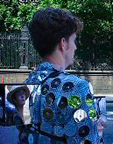
VOID: walking with Ulysses 1 by Susan Sakash, Trace, 23/Mar/2005.
A man, bedecked in a mirrored suit and wielding two video cameras strapped to his chest and back, moves in regulated sync with traffic signals and pedestrian flow through the city of Dublin. The mirrors place the man in a mobile aura of bouncing reflections. His gaze is fixated on the path in front of him; he does not make eye contact with the passersby who turn to stare after his receding figure. As his path abandons major tourist avenues, he is approached by a man who tries to engage him in conversation, saying that he is a reporter for a major Dublin newspaper. He is supposedly covering the Bloomsday activities and wants to know if this performance is part of the festival. The artist's gaze retains its focus on the intersection ahead. Mirrors do not speak back.
For four consecutive days in June of 2004, Robert Ladislas Derr engaged in VOID, a peripatetic performance, recording the dynamic movements of the city of Dublin via two video cameras mounted on his person. As Derr moved from the residential Mountjoy Square to McKenny bridge crossing the canal at Lower Mount Street, the cameras captured the reactions of fellow pedestrians as they alternated between observing and being observed. The video footage was subsequently shown later each day in a dual monitor installation at the Irish Film Institute in the Temple Bar Cultural Quarter of Dublin City Centre. Both the performative and documentary elements of VOID indicated Derr's desire to explore the conceptual duality of presence and absence, visibility and invisibility of the body's relationship to society.
VOID was one of 19 projects comprising the 2 week Wandering Rocks, Revolving Doors public art exhibition, part of the larger ReJoyce Dublin 2004 Festival celebrating the centenary of James Joyce's Ulysses. Each project evolved out of the artists' individual readings of Wandering Rocks, the 10th chapter of that book and one which is divided into 19 sections shaped by the actions and conversations of a number of minor characters as they wander through the streets of Dublin between the hours of 2:40 and 4:00pm on June 16, 1904. In recording these moments of minutiae, Joyce succeeded in creating a remarkable portrait of the city as it existed at the turn of the century.
Behind the conceptual underpinnings of the Wandering Rocks, Revolving Doors collective was my intention, as creative director and curator of the exhibition, to solicit public art works from an international network of artists that would propose new ways of interacting with Joyce and the city of Dublin in a fashion that still encouraged people to reflect on the movements and patterns of the city in both its historical and contemporary contexts. The event was situated somewhere outside the continuum that has seen the definition of public art move from the site-specific, static monuments of late modernism to the community-specific, socially engaged collaborations of the 90s. Built into Wandering Rocks, Revolving Doors conceptual framework was the idea that participating artists be relative strangers to the city of Dublin, familiar only with the city through Joyce's fictionalized descriptions. To respond to the city as depicted in Ulysses is to respond to a contemporary non-site, razed or buried beneath layers of urban regeneration.
Given the difficulty in defining a specific audience for this event and awareness on behalf of the artists that any attempts to create "community-specific" projects would be presumptive and inevitably isolate the very communities WrRd hoped to engage, artists adapted a variety of strategies. For VOID, Robert Ladislas Derr, whose video/performance pieces often echo the preoccupations of conceptual artists such as Vito Acconci and Lucas Samaras, sought to engage Guy Debord's "society of the spectacle." Rather than adopting the role of spectator, Derr attempted to become the spectacle himself. In Derr's own words:
Reflecting my surroundings, the mirrors created my void as I disappeared in the reflections from the city ... However, the reflections also created my presence ... the suit did more than emphasize my absence and presence, it made me a spectacle.
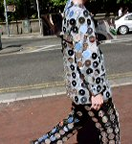
For Debord, the spectacle was "the autocratic reign of the market economy" and the colorful but empty gestures of those enlisted to divert attention from this accumulation of power. Correspondingly, Derr's suit of mirrors, dancing in the midday light, served to distract viewers from the subtly concealed video cameras he had installed inside mirrored boxes mounted from his shoulders. Like a media circus which reinforces the status quo it is meant to question, the actual spectacle of Derr's person is absent from the project's end product, namely the front and rear video footage recorded on his walks. Here, VOID becomes a subtle inversion of the domination of the spectacle: the ridiculous metaphor of the mirrored suit is but a means towards an end.
What is the end, then, that Derr had in mind? In pre and post event statements alike, Derr was preoccupied with the exploration of self through interaction and engagement with the other. He sought to render his own body as a kind of document of the city, exploring the patterns of habits and chance that lend shape to the specific life flow of a city. Again in Derr's words:
The walk becomes a study into psychogeography, where the geographic features of a city create similitude in daily life. The videos ... reflect my physical experience as I for example, step off the curb to cross the road at relatively the same time each day. My four-day repetitive walk mimics the routine of life.
Coinciding with the habitual patterns of city dwellers is the uncertainty of unanticipated encounters and discoveries: unknowns that add color and variety to our lives.
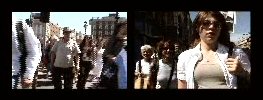
Derr's footage is testament to this interplay of repetition and surprise. As he travels the same route for four consecutive days at the same hour each day, the sights and basic patterns of the traffic may be similar but it is the particulars that demand attention. A man distractedly eating an apple at a traffic light, the impromptu dance performance of an overweight teen, a graphic oral display by a woman leaning out a pub - it is the "other" who replaces the artist as the director and actor of the unfolding drama. This celebration of minor characters, and the coincidence of habit and chance, emerge as central concerns for the artist, and were also omnipresent throughout Joyce's writing of Ulysses.
Derr's project, like many of the other participating components of WrRd, was careful to avoid responding to Joyce in a way that could be boiled down to mere mimicry of Ulysses. Specifically the path Derr chose to follow during VOID was not a literal retracing of any one character's travels during the Wandering Rocks chapter but rather a collection of movements and journeys. The parameters he set for himself before arriving in Dublin also allowed Derr's cameras to capture the contradictory elements of contemporary Dublin which lay subdued by the nostalgic, tourist-oriented, overtones of the ReJoyce Dublin festival. Rather, the footage poignantly evokes Guy Debord's call in his Introduction to Critique of Urban Geography for artists to observe:
... the sudden change of ambiance in a street within the space of a few meters; the evident division of a city into zones of distinct psychic atmospheres; the path of least resistance which is automatically followed in aimless strolls (and which has no relation to the physical contour of the ground); the appealing or repelling character of certain places.
It is interesting to note that, if we follow the ideological ambitions as set out by the psychogeographists, video art evolved as a reincarnation of their efforts to subvert spectacular displays of those in positions of power. Its affordability and accessibility as a recording device led video to be embraced by the early generation of video artists as a tool offering liberation via the imitation of society's habitual motions. The spectacle, they hoped, when turned back on itself, would implode.
At various stages throughout the development and realization of Derr's project, I was reminded of the ubiquitous presence of the closed circuit cameras that monitor public space throughout Dublin City Centre. Long a source of inspired indignation for multimedia artists, CCTVs' and their Big Brother associations, have proliferated in Dublin alongside the influx of capital and construction. Both CCTVs and the concealed cameras of VOID are to be viewed as tools of surveillance, their footage serving as archival documents. Closed circuit cameras are installed in static locations, meant to safeguard private property by recording the movements and actions of the unawares. While Derr's cameras were also recorders of the movements and actions of the unawares, their mobility canceled their effectiveness as agents of the spectacle.
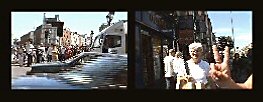
What differentiated Derr's surveillance technique from that of storeowners and city officials was that, in placing the cameras on his person, his surveillance of fellow pedestrians was no longer anonymous. Though the artist was physically absent on video, his authorial presence could always be intuited, evidenced in the faces and reactions of those recorded. Despite setting parameters, such as obeying all traffic symbols and refraining from conversation, to create the impression of objective documentation, Derr nevertheless produced a very human artwork.
Derr ended each day's performance of VOID on a small bridge crossing the lower canal. Solitary and stationary at last, the artist stood facing west, eyes still focused on the horizon. Meanwhile the footage captured, in its closing moments, images of the canal's mirrored surface. Though this scene retains its familiar composition, one is acutely aware that the water flowing beneath is, like the city it courses through, in a state of flux. The waters wink back at the cameras, recording their own ephemeral impressions at the edge of a historic city.
Since its realization and presentation in Dublin, VOID was recently exhibited in early February 2005 at Technology in the Life World at Open Space, Victoria, Canada, curated by Julie Andreyev as part of the Interactive Futures conference. Most recently, Derr was asked to exhibit and present VOID at the New School Graduate Faculty's conference on Words, Images, and The Framing of Social Reality in mid April.
VOID has influenced Derr's current video performance project American Sites. A multi-year research project, American Sites explores issues of place in the landscape, as a selected and constructed text. Wearing four cameras capturing four simultaneous views of the cardinal directions, Derr will investigate approximately thirteen geographic places across the US that experienced a significant event in U.S. history. Tracing the routes of Paul Revere's ride through Boston and President Kennedy's assassination in Dallas, Texas, American Sites will record and retrace past events infused with historic and personal memory. Like VOID, Derr's physical person will be visually absent, however the four-parameter views will still pick up the presence of his body in motion, thus creating and reinforcing the void.
View Quicktime movie clip provided for trAce by Robert Ladislas Derr. Please be patient while movie loads.
Susan Sakash is a curator and arts administrator fascinated by the ways in which humans create communities with fellow human beings as well as their animate and inanimate surroundings. Most recently, she was the Creative Director of the 'Wandering Rocks, Revolving Doors' public art exhibition in Dublin, Ireland (June 2004) and participated as organizer/artist in eXpuestos, a month long series of public art interventions in Panama City Panama (March 2004). Currently living in Boston, Massachusetts (USA), Susan is co-curator of public art programming at the Berwick Research Institute, an artist-run non-profit that provides alternative programming and exhibition space for artists who work outside the commercial world.
Links
Robert Ladislas Derr:
http://www.portfolios.com/rlderr
Archival documentation of Wandering Rocks, Revolving Doors:
www.newgroundcenter.org/WrRd
Guy-Ernest Debord, The Society of the Spectacle:
http://library.nothingness.org/articles/SI/en/pub_contents/4
Psychogeography:
http://www.psychogeography.org.uk/
Generative Psychogeography:
http://www.socialfiction.org/psychogeography/
Julie Andreyev:
http://www.eciad.ca/~jandreye/
trAce links
Data and Narrative: Location Aware Fiction:
http://trace.ntu.ac.uk/Opinion/index.cfm?article=83
Interactive Futures: New Stories, New Visions :
http://trace.ntu.ac.uk/Review/index.cfm?article=60
New Media Conferences: A Curator's View:
http://trace.ntu.ac.uk/Process/index.cfm?article=75
Posted by jo at 04:05 PM | Comments (0)
September 12, 2006
CONFLUX 2006
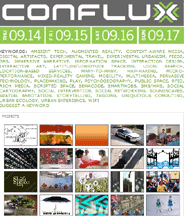
Festival for Contemporary Psychogeography
CONFLUX 2006 begins this week, and we invite all of you to join us! This year's Conflux will take place September 14 - 17th, headquartered at the McCaig-Welles Gallery in Brooklyn. Over 80 artists from across the US and countries including Canada, UK, Spain, Germany, Finland, Sweden and Australia will come to Williamsburg to present projects including experimental walking, biking, boat and public-transport tours; street games and tech workshops; mobile broadcasts, performances and temporary installations. For more information, including a detailed schedule, project descriptions, and contributor bios, please check the Conflux website! [posted by krista on Glowlab]
KEYWORDS: AMBIENT TECH, AUGMENTED REALITY, CONTEXT-AWARE MEDIA, DIGITAL ARTIFACTS, EXPERIMENTAL TRAVEL, EXPERIMENTAL URBANISM, FEEDS, GPS, IMMERSIVE NARRATIVE, INFORMATION SPACE, INTERACTION DESIGN, INTERACTIVE ART, LATITUDE/LONGITUDE TRACKING, LOCAL SEARCH, LOCATION-BASED SERVICES, MANY-TO-MANY, MAP-MAKING, MICRO-PERFORMANCE, MIXED-REALITY GAMING, MOBILITY, MULTIMEDIA, PERVASIVE TECHNOLOGY, PLACEMAKING, PLAY, PSYCHOGEOGRAPHY, PUBLIC SPACE, RFID, RICH MEDIA, SCRIPTED SPACE, SEMACODE, SMARTMOBS, SMS/MMS, SOCIAL CARTOGRAPHY, SOCIAL INTERVENTION, SOCIAL NETWORKING, SOUNDSCAPES, SPATIAL ANNOTATION, STORYTELLING, TAGGING, UBIQUITOUS COMPUTING, URBAN ECOLOGY, URBAN EXPERIENCE, WIFI.
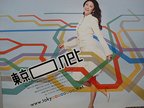
Killing the Fathers, or: If You Meet Jane Jacobs On The Road...
Adam Greenfield
This is a short talk about a great many complicated things: about urban form in an age of mobile, ubiquitous and pervasive computing; about how our relations with places familiar and unfamiliar change as a result of our engagement with new information technologies; and, above all, about how we may need to jettison our dependence on the beloved heroes and heroines of 20th century urbanism in order to understand what's happening all around us.
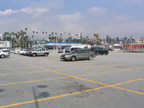
Parking Public
Ryan Griffis
Parking Public is an investigation into the realities of utopian thought as materialized in the mundane and pragmatic spaces of parking lots. Parking lots, one of the most visible, yet overlooked, artifacts of American mobility reveal the concrete space required to store the supposed tools of utopian ideals. Parking Public is a mapping of these literally concrete spaces in an attempt to locate the utopia they serve. Underneath both the empty spaces of parking and the empty promises of utopia are real economies and structures of power. For Conflux 2006, The TTO will offer a guided tour of parking in the Brooklyn area that will also serve as a participatory mapping of personal utopias upon the topography of property development. These tours will add to the Parking Public database of research on parking and utopias. This tour will be conducted by van, and can accommodate 11 people. If you would like to RSVP for the tour, to ensure a seat, please visit: temporarytraveloffice.net/rsvp The Temporary Travel Office has created tours of parking lots in Hollywood, historic downtown Los Angeles and Champaign, IL. These tours are augmented with distributed surveys, in embodied space and on the web, recording the utopian desires of the users. Cell phones will allow people to participate in the phone survey, but are not necessary.
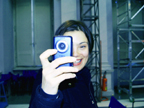
In the intimacy of the city
Régine Debatty
Designers, artists, and hackers have been very active over the past few years trying to find a way to reclaim the boundaries that we routinely create in our use of public space and that neither passersby nor electromagnetic fields respect.

Stations of a Commute
Nita Sturiale
Stations of a Commute is a series of audio tracks designed to be listened to during an urban commute away from one's loves - whether children, partners or life work. There are 14 stations in all, each preceded by instructions as to where they should be performed. The stations provide an opportunity to practice a walking meditation in the face of the city's noise and entropy, while also celebrating the community, culture and diversity the city provides. These 14 stations can be performed on any commute away from your loved ones and/or obligations. Listen to the narrations with a meditative and solemn approach. Stop walking, pull the car over for a moment. Take a breath. Reciprocate. This project is available as a Podcast from http://www.stationsofacommute.com or as a limited edition audio CD available during CONFLUX. Users will need either an iPod or a portable CD player to experience Stations of a Commute. The duration is as long as your commute is.
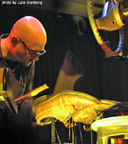
Radio Wonderland
Joshua Fried
A solo performance in which I subvert the local media stream--live FM radio--into recombinant funk. While the processing is all in the laptop, the tools are surreal: a real steering wheel (from a Buick), four old shoes hit with sticks, and a classic ‘80s boom box from which the original sound source emanates: all of it. Live. All radio bits are to be equally abstracted, recontextualized--stripped of their ability to soothe and distract. I want to show those who may be cowed by technology and media that we can manipulate the neverending flow. Therefore the processing is simple: framing, reshuffling, repeating, transposing. The surreal touch of ordinary objects (shoes, wheel) underscores the basic, congenial nature of the transformations. So, too, my riffs must be vernacular, and not elite. I want my audience to go home and start messing with their own radios--or TVs--with just a volume knob and tuner.
And much much more....
Posted by jo at 06:44 PM | Comments (0)
September 06, 2006
Upgrade! New York
![]()
Catherine D’Ignazio a.k.a. kanarinka
Upgrade! New York: September 14, 7:30 pm :: The Change You Want to See Gallery and Convergence Stage :: 84 Havemeyer Street, Store Front @ Metropolitan Ave, Brooklyn, NYC
Are locative media and psychogeography projects just entertainment for white, middle-class, gadget-oriented consumers? Mapping impulses, locative media projects and psychogeographic investigations of place and community have proliferated over the past decade. There is a rich, interdisciplinary field of practice and new strategies, tactics and tools are being invented all the time. However, there is also the need for critical evaluation and discussion of the relevance and impact of these cultural projects. Factors of race and class are often overlooked. Connections to the material (often military and corporate) circumstances of the development of technologies deployed in these projects are often swept aside. Through the increasing corporatization and militarization of participation and play (Web 2.0, Joint Red Flag military war game), it is clear that more participation and play does not mean more democracy and freedom. On the contrary, participation and play are also deployed as mechanisms of social control.
Catherine D’Ignazio a.k.a. kanarinka will discuss several collaborative projects from her practice, show other examples of contemporary psychogeographic investigations and then open the forum for others to do the same. The goal of the talk is to discuss three questions:
1) Is locative media/psychogeography work just entertainment for white, middle-class, gadget-oriented consumers? (Hopefully the answer is no, but we’ll see.)
2) What is at stake in the corporatization and militarization of “play” and “participation”?
3) What kind of agency do these projects have? i.e. What do they really do?
TO BRING (optional): Failures & successes. Bring a psychogeography/locative media project to share with us, including your commentary about what kind of agency it produces, how it addresses its audience, and so on. Both failures and successes - and the numerous projects that have both - are useful.
LATER: We will proceed to the opening for the Conflux Festival at Supreme Trading Post to continue the conversation.
Posted by jo at 01:44 PM | Comments (0)
September 04, 2006
From Here to There

Under an Umbrella
From Here to There Under an Umbrella by Chris Barr: The "Under an Umbrella" project stems from an experience that I had as a freshman in college, in which a younger version of myself offered a young lady a spot under an umbrella during a rainstorm. From that rainy two-block walk and the conversation that it allowed, an exuberant yet naive relationship developed.
For three days during Conflux I will offer to escort local residents and festival participants to their desired location under an umbrella, as a sort of umbrella taxi. Our walk and conversation will be recorded via an "umbrellacam" and will be uploaded to the project website. With this experiment I am interested in how a shift in spatial experience, i.e. a space designed for one being used for two, can shift other relationships such as communication. And how something such as our vulnerability to our environment can offer us unique (and sometime intimate) human experiences.
Participants can sign up for a walk at UnderAnUmbrella.com or call (716) 512-9254. The project will run Friday September 15 through Sunday September 17 from 8am - 4pm with documetation available on the project website.
Posted by jo at 11:18 AM | Comments (0)
August 30, 2006
The Bubble Project
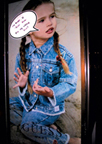
From Corporate Monologue to Public Dialogue
The Bubble Project is created by Ji Lee and is a comment on the fact that communal spaces to an ever increasing extent are being filled with ads of various kinds. The idea behind the project is to place Bubble stickers on the physical ads, thereby transforming them from corporate monologue into a dialogue open to the public. The Bubble stickers are meant to encourage anyone to fill them in with any form of self expression, free from censorship.
The Bubble Project is presented at this years Conflux festival for contemporary psychogeography, which takes place in Brooklyn, NYC, September 14-17. The Conflux festival investigates the everyday urban life through emerging artistic, technological and social pratice.
Also check out the online bubbles. [blogged by Lene Mailund on Digital Experience]
Posted by jo at 07:15 PM | Comments (0)
August 22, 2006
[iDC] Interactive City: irrelevant mobile entertainment? Part 2
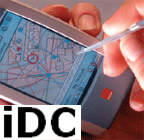
Mark Shepard's Response
It's encouraging to find such an outpouring of interest and critique on the subject of locative media and its relation to pyschogeography, mapping and urban play. While we had originally planned on addressing many of these issues in September as part of the Architecture and Situated Technologies thread, I think the current discussion provides an opening to address how an evaluation of certain locative media practices (and their failures) might provide a "sandbox" for thinking through the opportunities and dilemmas of a near-future world of networked "things". From locative media to atoms, bits and ubiquity.
As someone whose interest in the Situationists predates my work in new media, I have long felt uncomfortable with media art practices that claim or aspire to transpose concepts of pyschogeography and tactics of the dérive or detournment to contemporary urban environments. It is critical to remember that the dérive emerged in a specific historical context, one that I would argue no longer holds. In part a response to 20th century urban planning strategies promoted by modern architects associated with CIAM (Congrès International d'Architecture Moderne), the dérive sought to reclaim a space for the creative capacities of an imaginative subject in face of an onslaught of the functional rationalization of modern capitalism. CIAM's strategies aimed to reorganize the city - perceived as an ailing beast in need of a cure - through a strict functional segregation of dwelling, work and recreation (leisure) zones connected by rationalized transportation corridors.
Citing a 1952 study by Parisian sociologist Chombart de Lauwe that mapped the movements made in the space of one year by a student living in the 16th Arrondissement, Debord expresses outrage that her itinerary "forms a small triangle with no significant deviations, the three apexes of which are the School of Political Sciences, her residence and that of her piano teacher." [1] To a certain extent, the dérive was conceived to explicitly counteract this rationalization of patterns of movement through the city and the corresponding limitations imposed on the diversity, messiness, and richness of urban life. Understood as a form of ludic play, the expressed aim was to free people from "their relations, their work and leisure activities, and all their other usual motives for movement and action, and let themselves be drawn by the attractions of the terrain and the encounters they find there." With regard to kanarinka's comment about the gentleman invited to drift with them who "summed it up nicely" by saying "Sorry, I can't go with you. I have to work here until 8PM and then I have to go to my other job," I would argue that it is precisely this mentality that the dérive sought to address.
In evaluating locative media projects claiming or aspiring to a Situationist agenda, I often find myself questioning to what extent their deployment of mobile technologies ends up actually reifying this rationalization of patterns of use or movement. Put another way, to what extent do conventions for the use of consumer mobile technologies actually contribute to CIAM's agenda in their codification of modes of interaction with and within the contemporary city? Perhaps the most pertinent question for locative media might be: how might these technologies be (mis)used in an attempt to counteract (rather than reinforce) an ongoing rationalization and commodification of urban life? It would seem less a question of "locating" oneself, perhaps more one of getting lost...
Brian Holmes' critique of locative media [2] focused on a perceived noncritical ("naive") adoption of GPS technologies and Cartesian mapping systems in the context of Situationist aesthetics. Specifically, Holmes attacks the non-reflexive use of technologies developed by the military and their domestication in the context of scenarios of play, where aesthetics becomes politics as decor. This critique was originally delivered at a workshop held at the RIXC center in Latvia in 2003. Since then the field has expanded significantly, and while early locative media projects may have relied heavily on these technologies, it would be difficult to identify locative media exclusively with either GPS or Cartesian mapping today. At the same time, some contemporary projects built on GPS are far more reflective of the dark side of locative media. [3] This is not to say Holmes' critique no longer holds. Quite the contrary, as it would seem it has been in many cases internalized by the field. While this year's ISEA / ZeroOne San Jose symposium and exhibition presented a few GPS-based locative media projects, they were by no means the majority. Drew Hemment et. al.'s LOCA project is one example of a "pervasive surveillance project" aimed at raising public awareness of how certain consumer technologies (bluetooth in this case) enable tracking in ever more subtle ways. [4] Alison Sant's paper "Redefining the Basemap" [5] addressed the fact that many locative media projects still "remain bounded by datasets that reinforce a Cartesian and static notion of urban space" and made a call for alternative methods of mapping the city, particularly ones addressing the temporal dimension of urban experience.
The critique of GPS and Cartesian mapping systems is by no means new. Laura Kurgan's exhibit "You Are Here: Museu" (1995) [6], addressed the uncertainties that arise when relying on satellite tracking systems to know "where we are." Architect Stefano Boeri's essay "Eclectic Atlases" (1997) [7] addresses the failure of satellite imagery to adequately represent the contemporary metropolis and calls for alternate methods for mapping the city as experienced "on the ground." The exhibition and catalogue for "The Power of the City: The City of Power" (Whitney Museum of American Art, 1992) [8] explores alternative mapping practices of conceptual and performance art from the 60s and 70s in terms their relation to Baudelaire's Flaneur, Jameson's notion of cognitive mapping, and (then) contemporary readings of Situationist aesthetics. Kevin Lynch, in his oft cited treatise "The Image of the City" [10], acknowledged that the emotional dimension(s) of his cognitive maps were beyond the reach of his research methods. More recently Marina Zurkow, Scott Patterson and Julian Bleecker's "PDPal" (2003) [9] asks what might an "emotional" GPS look like?
Perhaps the most interesting take on the relevance of locative media today is that of Marc Tuters and Kazys Varnelis as expressed in their essay "Beyond Locative Media," published by Leonardo in conjunction with the Pacific Rim Summit [11]. Acknowledging that locative media has been attacked for its ambivalence with regard to commercial interests and its reliance on Cartesian mapping systems, they find these critiques nostalgic, "invoking a notion of art as autonomous from the circuits of mass communication technologies", which they argue no longer holds. Moreover, they make the case for locative media as a "conceptual framework by which to examine the certain technological assemblages and their potential social impacts. Unlike net art, produced by a priestly technological class for an elite arts audience, locative media strives, at least rhetorically, to reach a mass audience by attempting to engage consumer technologies, and redirect their power." At the dawn of an age where ubiquitous networked objects outnumber humans as generators and receivers of information, this effort is more important than ever.
+++
[1] Guy Debord. "Theory of the Derive" - http://library.nothingness.org/articles/SI/en/display/314
[2] Brian Holmes. "Drifting Through the Grid: Psychogeography and Imperial Infrastructure" - http://www.springerin.at/dyn/heft_text.php?textid=1523&lang=en
[3] See the Institute for Applied Autonomy's "i-SEE - Now More than Ever" - http://www.appliedautonomy.com/isee.html or Annina Ruest's "Track the Trackers" - http://www.t-t-trackers.net/
[4] LOCA - http://www.loca-lab.org/
[5] Allison Sant. "Redefining the Basemap" - http://www.intelligentagent.com/archive/ia6_2_interactivecity_sant_baseline.pdf
[6] Laura Kurgan. "You Are Here: Museu" - http://www.l00k.org/youarehere/you-are-here-museu
[7] Stefano Boeri. "Eclectic Atlases" in The Cybercities Reader (NY: Routledge, 2003)
[8] Cristel Hollevoet, Karen Jones, Timothy Nye. "The Power of the City: The City of Power (NY: The Whitney Museum of American Art, 1992)
[9] Marina Zurkow, Scott Patterson and Julian Bleecker. "PDPal" - http://www.pdpal.com/
[10] Kevin Lynch. "The Image of the City" (MIT, 1960)
[11] Marc Tuters and Kazys Varnelis. "Beyond Locative Media" - http://netpublics.annenberg.edu/locative_media/beyond_locative_media
+
mark shepard
+
http://www.andinc.org
iDC -- mailing list of the Institute for Distributed Creativity (distributedcreativity.org) iDC[at]bbs.thing.net http://mailman.thing.net/cgi-bin/mailman/listinfo/idc
List Archive:
http://mailman.thing.net/pipermail/idc/
Posted by jo at 10:03 AM | Comments (0)
July 13, 2006
GLOWLAB 09: july :: august 2006

Networks, Mobility, Interventions
The projects in Glowlab 09 examine urban architecture by investigating the social spaces enabled by public networks, mobile communication devices and direct intervention. In viewing the work, one might re-imagine the city as space which is defined through the nature of the interactions that take place within it.

Public Broadcast Cart by Ricardo Miranda Zuñiga: Transforms a shopping cart into a mobile radio station, transmitting via miniFM and the Internet. The Public Broadcast Cart is designed to enable any pedestrian to become an active producer of a radio broadcast by reversing the usual role of the public from audience to producer.

Hundekopf by Brian House and Sue Huang (Knifeandfork): A location-based narrative project utilizing SMS text-messaging to explore the experience of riding the Berlin Ringbahn.

Relay: Toronto by Germaine Koh: An architectural intervention that turns a building into a sort of urban lighthouse, relaying text messages received on a mobile phone by flashing the building lights in Morse code.

Lee Walton's Western Shift by Allard van Hoorn: An open-environment collaboration between researchers, architects, designers, artist, curators and all kind of cultural producers. Its aim is to stimulate fresh ways of looking at urban living and discover alternative solutions.

SpeedWave by Otino Corsano: A photographic based performance piece inspired by the established location of a regularly monitored Toronto speed trap. A camera on a tripod replaces the laser gun to document waves of local traffic.

Talking Cities [magazine review] by Krista Jenkins: A review of the recently published Talking Cities magazine, the print accompaniment to the exhibition of the same name, taking place at Zeche Zollverein in Essen, Germany.
Glowlab is an artist-run production and publishing lab engaging urban public space as the medium for contemporary art and technology projects. We track emerging approaches to psychogeography, the exploration of the physical and psychological landscape of cities. Our annual Conflux festival, exhibitions, events and our bi-monthly web-based magazine support a network of artists, researchers and technologists around the world.
Posted by jo at 02:11 PM | Comments (0)
July 11, 2006
Simon Elvins' Silent London
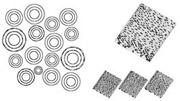
Mapping Sound
Simon Elvins is concerned with sound as an ubiquitous force. Through a series of projects he has been documenting how sound is an often ignored dimension of our physical environment. Silent London plots quiet spaces in the English capitol using noise level data. An embossed print shows quiet areas raised up from the paper, bringing them to the attention of the viewer, while noise areas become blanked out valleys. noisy areas raised up from the paper while quiet areas become blank areas of peace. His FM Radio Map serves a dual purpose. On the one hand it plots the physical locations of commercial and pirate FM radio stations broadcasting in London. But circuits conductive pencil lines placed on the back of the map also turns it into a physical interface. Using a modified radio the map can be aurally “navigated” by placing metail contacts on points on the map.
These projects are poetic but ultimately functional. Taking a conceptual design approach (Elvins studied Communication Art & Design at the Royal College of Art), they present numerical data in an aesthetic context. By choosing low-tech materials (paper, electronics) Elvins creates fragile objects whose material qualities belie their sophisticated technical content.
Simon Elvins is concerned with sound as an ubiquitous force. Through a series of projects he has been documenting how sound is an often ignored dimension of our physical environment. Silent London plots quiet spaces in the English capitol using noise level data. An embossed print shows quiet areas raised up from the paper, bringing them to the attention of the viewer, while noise areas become blanked out valleys. noisy areas raised up from the paper while quiet areas become blank areas of peace. His FM Radio Map serves a dual purpose. On the one hand it plots the physical locations of commercial and pirate FM radio stations broadcasting in London. But circuits conductive pencil lines placed on the back of the map also turns it into a physical interface. Using a modified radio the map can be aurally “navigated” by placing metail contacts on points on the map.
These projects are poetic but ultimately functional. Taking a conceptual design approach (Elvins studied Communication Art & Design at the Royal College of Art), they present numerical data in an aesthetic context. By choosing low-tech materials (paper, electronics) Elvins creates fragile objects whose material qualities belie their sophisticated technical content.
Parallel to Elvin’s interest in sound is his fascination with mapping of physical and intangible forces. Both the aforementioned projects are classic mapping projects, while Notation is a more abstract exploration of how sound can be represented visually as marks on paper. Reminiscent of experiments with graphic notation (see Eno etc), the project consists of studies of representations of tonal patterns using pencil on paper.
The Notation project page seems to indicate that these drawings can ultimately be used to produce sound, but no details are available. If so, it would be an inversion of Elvin’s excellent Paper Record Player, where he constructed a functional record player out of paper, complete with its own conical paper amplifier.
(Thanks to TomC. See also Mount Fear.) [blogged by Marius on Generator.x]
Posted by jo at 09:24 AM | Comments (0)
July 06, 2006
Always ON
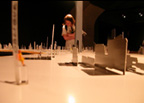
New Augmented Space and its Memory
The concepts of place, proximity and distance are going to be substantially rewritten by the locative media evolutions. The origins of this process are not only related to the abstract digitalization or to the latest hi-tech gadgets, but they are more significantly rooted in social changes induced by the overflowing of the net space. The social access and the subsequent construction of net space started in middle nineties, so the perceived 'space', as a public, collective and shared dimension was slowly literary doubled in the digital dimension. The next step is the actual ongoing process of joining back these two halves (real and virtual space) in an augmented reality that is a real experience. If the man on the moon broke the 'external' boundaries perception of that time, the net integrated in the urban space has definitively broken the actual inner spatial boundaries outdating the established physical perception as the only possible coordinates to sense the space.
The net is based on one hand on a subject (its IP) directly addressable from every (good or evil) point of view. On the other hand the same subject is able to add his own data and memory to his own space, building a digital environment piece by piece. These tough changes are investigated and enhanced in the impressive work made by the Sonarama 2006 curatorial team (José Luis de Vicente, óscar Abril Ascaso and Drew Hemment and Advanced Music). After Micronations (2004) and Randonnée (2005) the last part of this contemporary territory conceptual mapping has been accomplished through a selection that emphasize different "permutations of the mobile syntax" as de Vincente defines it. In the ground floor of the CCCB, the exhibited works were placed in dark corridors and rooms, that like a maze, was an ideal location.
The most awaited project was undoubtedly Blast Theory's premiere of 'The day of the figurines', a social multiplayer game played via sms, reflected in a fictitious world of real figurines. With more than three hundred players in three days (actually it can hosts up to one thousand players) it shaped a small world that was reflected in a physical update. In fact authors moved figurines and forms by hand every twenty minutes, updating the representation of the online latest developments. Here again the usual 'virtualization' of reality structures was inverted. The process was the opposite of webcams: instead of taking a glimpse of a real space, the mapping of the online process was a slow update of a plastic scenario, much more attractive and meaningful to our instincts than a real-time colorful graphic on a screen. In the locative media horizon, many are the shades of the distance.
Zexe.net was a project by The Golden Nica winner Antoni Abad with the same concept of giving mobile phone with cameras to special group of people and selecting their pictures/vision, focused on latin taxi drivers, gipsies and prostitutes. How far is their own landscape, represented through our shining technology? And changing perspective how far is our own home, if we can easily see it from a satellite view? Jeremy Wood's Meridians, a psychogeography text composed as a gps-draw on a very famous London area, remind us the shock of zooming on a photograph (not anymore an abstract color representation) of our own daily territory. This is impacting our neighborhood vision, temporary establishing a center where we live (or we are at the moment) and considering the world as a surrounding. It's a sort of ego-geography, able to stunningly visualize as real what we've already seen as a zoomed out draw.
Amongst the other showed (or performed) projects included Michelle Teran's classic Life's a User's Manual, Counts Media social platform Yellow Arrow, the last Transmediale software art award winner Socialfiction's .walk (article on Neural 23), another psychogeographical approach in Alejandro Duque's TTSM (Typewriter Tracklog sewing Machine), a new iPod version of the imaginative G-Player, the relationship between space and sensations in Christian Nold's Bio Mapping, the performance by accident, treasure hunt Geocaching practices and the RFID hacking of Preemptive media's Zapped! like the coackroach with an RFID on his back confusing a supermarket reader because of its unpredictable movements. The urban space is a collective memory mirror. And the memories of the last thirty years have been mediatised more than any previous period. The process of easily juxtaposing personal memories, histories and territories would enable another new level of consciousness of reality, stratified on our mediated identity. View the Sonar 2006 photo gallery. [posted on Neural]
Posted by jo at 12:27 PM | Comments (0)
May 30, 2006
SonarMatica presents Always On
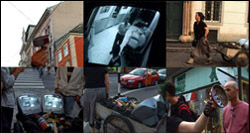
Into the Streets
ALWAYS ON--curated by Drew Hemment, José Luis de Vicente, Óscar Abril Ascaso and Advanced Music--is a display dedicated to mobile culture and location projects. It is an initiative based on exhibition and participation, taking SonarMática out onto the streets for the first time. Advance tickets for Sónar by Night as well as general passes for the three days and two nights of Sónar 2006 are already on sale.
This year, Sonarmatica presents itself more participative than ever: a game involving relationships using mobile telephones for nine hundred players at the same time organised by Blast Theory; a walk through Barcelona's electromagnetic old quarter of Ciutat Vella with Michelle Teran; and a geocaching session are some of the ideas at the exhibition.
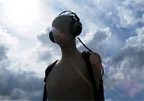
:: Participation Projects :: Those wishing to register to take part in the participation projects should go to the information stand in the exhibition: Blast Theory (UK), Day of the Figurines; Michelle Teran (CA), Life: A User's Manual; Akitsugu Maebayashi (JP), Sonic Interface; Counts Media (US), Yellow Arrow; Geocaching
:: Exhibition Projects :: Antoni Abad (ES), Taxistas, gitanos y prostitutas transmiten desde móviles en www.zexe.net; Alejandro Duque (CO), TTSM, http://soup.znerol.ch, http://co.lab.cohete.net, www1.autistici.org/communa/platanal;
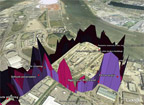
Jeremy Wood (UK), Meridians; Jens Brand (DE), gPod / G-Player; Preemptive Media (UK), Zapped!; Proboscis (UK), Urban Tapestries / Social Tapestries; Christian Nold (UK), Bio Mapping; Mark Shepard (US), Tactical Sound Garden Toolkit; Socialfiction (NL), .walk; Jeff Knowlton / Naomi Spellman (US), The Interpretive Engine for Various Places on Earth; ExtraMàtica, raster-noton, Essential Room.
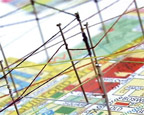
Advance tickets for Sónar by Night as well as general passes for the three days and two nights of Sónar 2006 are already on sale. Advance Tickets On-line: www.ticktackticket.com. By phone: +34 93 445 06 60: from abroad, opening hours Mon-Fri from 10.00am to 10.00pm; 902 150 025: from Spain, opening hours Mon-Sun from 10.00am until 10.00pm, from abroad, opening hours Sat-Sun from 10.00am until 10.00pm.
At any www.ticktackticket.com Sales Centre in Spain. At FNAC in France, Switzerland and Belgium: (www.fnac.com). Distribution cost not included.
Note: Neither general passes nor accreditations give admission to the Thursday the 15th concert at the L'Auditori de Barcelona
All the information at:
www.sonar.es/sonarmatica
Posted by jo at 08:55 AM | Comments (0)
May 26, 2006
HTTP Gallery
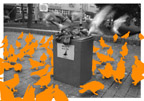
Urban Eyes
HTTP Gallery is pleased to present Urban Eyes, an intermedia project by Marcus Kirsch and Jussi Angesleva. Private View: 1st June 2006 7-9pm; Exhibition: 1st June - 9th July 2006, Friday- Sunday: 12 noon-5 pm; Unit A2, Arena Business Centre, 71 Ashfield Rd, London N4 1NY; tel: + 44 (0)20 8802 2827; info[at]http.uk.net
Urban Eyes uses wireless technology, birdseeds and city pigeons to reconnect urban dwellers with their surroundings. The Urban Eyes feeding-platform stands in one of London's public spaces. By landing on the platform, pigeons tagged with RFID chips send aerial photographs of their locality to surrounding Bluetooth-enabled devices. In this work pigeons become maverick messengers in the information super-highway, fusing feral and digital networks. HTTP Gallery provides an interface to the project, mixing live and documentary footage and offering visitors an opportunity to experiment with Bluetooth.
Being one of the last remaining signs of nature in a metropolis such as London, the urban pigeon population represents a network of ever-changing patterns more complex than anything ever produced by a machine. However pigeons' movements are based on a one-mile radius around their nest. Any pigeon you see everyday shares the same turf as you. Urban Eyes crosses and expands human mobility patterns offering to reconnect you with your neighbourhood.
In the 1960s, situationists Debord and Jorn composed psycho-geographic diagrams of Paris, which described navigational systems based on their drift through the city. For this, they used Blondel la Rougery's Plan de Paris a vol d'oiseau, a bird-eyes map of Paris. Inspired by this methodology, Urban Eyes enlists our feathered neighbours to establish a connection between the bird-eyes view of the city as now distributed by Google Earth and our terrestrial experience. [Related]
About Marcus Kirsch and Jussi Angesleva
Marcus Kirsch holds an MA in Interaction Design from Royal College of Art. He was invited to the 2004 Seoul Biennale and as exhibiting artist and to last year's Rotterdam International Film Festival and DEAF Festival. He was awarded a silver Art Directors Club NY and a fusedspace.com award in collaboration with Jussi for 'Urban Eyes'.
Jussi Angesleva holds MA in Audio Visual Media Culture from the University of Lapland in Finland, and MA in Interaction Design from the Royal College of Art and has shown at the Tokyo Metropolitan Museum of Photography, Siggraph, ZKM and Science Museum London. He has received awards from Royal Society of Arts, NESTA, from D&AD (together with Ross Cooper), Prix Ars Electronica and the Art Directors Club of Europe. He is currently working at ART+COM in Berlin, Germany and is a co-founder of new media agency Prosopon.
For more information and images, please contact Stephanie Delcroix
This project is supported by Arts Council England (London), V2 lab (Rotterdam, Netherlands) and Furtherfield.org.
Posted by jo at 05:36 PM | Comments (0)
March 19, 2006
A Mis-Guide to Anywhere

A Travel Guidebook Remapping Public Space
A Mis-Guide To Anywhere is a utopian project for the recasting of a bitter world by disrupted walking. Mis-Guides are the travel documents to your distinationless journeys. Mis-Guidance is a walk in the park.
Anywhere you can walk slowly down the street without being shot at by Western contractors. Anywhere you can reorganise buildings without permission. Anywhere you can stand still without being questioned. Anywhere you can find abandoned beds. Anywhere the movie you always wanted to see is playing. Anywhere you legged it.
Produced by Wrights & Sites, working with the visual artist Tony Waver. [A book] Available from 8 April 2006.
Posted by jesse at 11:54 PM | Comments (0)
March 01, 2006
CONFLUX 2006
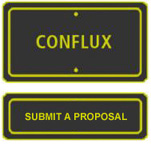
Call for Submissions
CONFLUX 2006 - September 14 - 17. 2006--Conflux is the annual New York City festival where visual and sound artists, writers, urban adventurers, researchers and the public gather for four days to explore the physical and psychological landscape of the city. Say hello to Brooklyn! In 2006, Conflux will be held in Brooklyn for the first time. McCaig-Welles Gallery in Williamsburg will serve as our headquarters, with events taking place in and around the gallery.
Conflux 2006 is produced by Glowlab and curated by Glowlab and iKatun.
HOW TO APPLY: Please read the guidelines below, and enter your submission online at: http://conflux2006.glowlab.com
SUBMISSION DEADLINE: 10 April, 2006, 11:59pm EST
CONFLUX SUBMISSION GUIDELINES: Participants in Conflux share an interest in psychogeography. Projects presented range from interpretations of the classical approach developed by the Situationists to emerging artistic, conceptual and technology-based practices.
At Conflux, participants, along with attendees and the public, put these investigations into action on the city streets. The city becomes a playground, a laboratory and a space for the development of new networks and communities.
WHAT TO SUBMIT: Here are examples of the types of projects and events we're looking for:
- exploratory drifts/dérives
- walks with hacked maps or experimental navigation techniques
- alt.tours by foot, bike, subway, bus
- social/environmental research and fieldwork
- workshops
- temporary public-space installations/interventions
- performance projects
- street games
- mobile-tech/locative media projects
- social networking projects that focus on cities and urban life
- project presentations, panel discussions and lectures.
- film/video works for a film series event.
- audio projects and musical performances for night events
Projects may take place in the neighborhood surrounding the gallery, in
other public-space locations in NYC, in the gallery or in a different venue
you provide.
PLEASE NOTE: We are not doing an exhibition this year. You may provide
handouts, maps, flyers, etc. for your project but not artwork for the walls.
There will be wi-fi in the gallery.
ABOUT FUNDING: Conflux cannot provide individual project funding, but we may be able to assist in other ways, such as providing a letter of support, the help of our volunteers and discounts at local restaurants and other businesses.
PROJECT SELECTION: These are the criteria the curators use in selecting projects for Conflux:
1. Relevance: How does the project relate to psychogeography? Does it address issues central to classic psychogeography and/or propose new methods? Does the project take a unique approach to exploring/understanding/changing the city and/or local neighborhood?
2. Experience: How do people experience the project? Is the public experience of the project well-thought-through? Does it encourage dialogue between the diverse communities of New York City?
3. Feasibility: Is the project scope reasonable? Does the project have its own funding? Can the participants travel to Conflux with their own funds?
SCHEDULE
10 April 2006: Call for Proposals deadline
01 May: notifications sent
14 - 17 September: Conflux 2006
QUESTIONS? Contact conflux[at]glowlab.com
ABOUT GLOWLAB: Glowlab is an artist-run production and publishing lab engaging urban public space as the medium for contemporary art and technology projects. We track emerging approaches to psychogeography, the exploration of the physical and psychological landscape of cities. Our annual Conflux festival, exhibitions, events and our bi-monthly web-based magazine support a network of artists, researchers and technologists around the world.
ABOUT iKATUN: In South Slavic, "katun" means "temporary village" and is used to designate seasonal communities near pastures and bodies of water. iKatun's mission is to foster and develop temporary communities that experiment with art, geography and political engagement in everyday life. iKatun provides fiscal sponsorship to artists, produces experimental educational gatherings such as conferences, walks and reading groups, and conducts field research with the Institute for Infinitely Small Things.
Posted by jo at 10:43 AM | Comments (0)
November 02, 2005
Sal Randolph
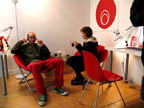
Opsound and Whereyouare
Last night at Upgrade! Boston, Sal Randolph presented two projects, Opsound and Whereyouare. Opsound is a gift economy in action, an experiment in applying the model of free software to music. Musicians and sound artists are invited to add their work to the Opsound pool using a copyleft license developed by Creative Commons. Listeners are invited to download, share, remix, and reimagine. Opsound is currently installed in the Glowlab: Open Lab exhibition at Art Interactive.
![]()
Whereyouare is an experiment in the collective documentation of neighborhoods. Randolph began the project with the idea of documenting her own neighborhood, Williamsburg, Brooklyn, whose quirky and ephemeral beauties are currently endangered by a wave of new development. Everyone is invited to participate by documenting any neighborhood they love. Those with material from neighborhoods which have now been damaged or destroyed by Katrina are especially encouraged to contribute.
Posted by jo at 11:29 AM | Comments (0)
October 25, 2005
Morgan Schwartz
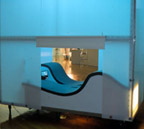
Chance Encounters, Deliberate Interventions
Pursuit of Happiness: Porta-Sky is an urban sanctuary and think tank for two. Periodic trips into the dark relaxation chambers of movie theaters became a routine survival technique for the subjects of modern society. In our post-modern world, where work and leisure have collapsed, the Internet has become a space of convergence. "Porta-Sky" is a physical corollary – a non-space, a hallway from here to there. Providing a personal view of a virtual sky, this video projection space offers alternate imagery to an anxiety-ridden sky. The unit features dual, synchronized DVD video projections, a deployable surveillance blimp and custom designed form-fitting reclining seats.

Situated in the Gallery@Green St (adjacent to the Green St. Subway station on the Orange Line in Boston, MA), Pressure was a site specific installation where computer controlled sensors manipulated the sights and sounds of daily commuting to address issues of accelerated culture and the evolving metaphors for speed and progress. Pressure seeked to explore the psychology and physicality of individuals in the contemporary urban landscape.
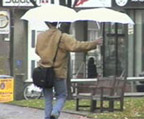
umbrellaSpace is an urban gesture. It is a design solution to a social problem. The intervention adjusts perceptions of boundaries and comfort held by observers on the street. This umbrellaSpace adopts the umbrella as a familiar, recognizable, urban form and recreates it. A permeable space of interaction is transformed from a private, individualized space. An individual in the urban sphere operates this new umbrellaSpace. He or she can choose to invite people on the street into this space. I’m interested in exploring the range of responses this intervention precipitates on the street: sociological, visual, performative. Schwartz is looking for people interested in operating the UmbrellaSpace as well as videographers and photographers interested in documenting the events.
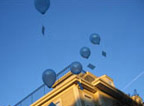
Currently in development at the Berwick Research Institute and on exhibit at Glowlab: Open Lab, Whether/Weather consists of aerial beacons that are dispersed into the weather system. The beacons are helium powered with LED blinkers. Like seeds, these beacons drift with the wind and carry information/stories/memories that hopefully germinate wherever they land. Whether used by an individual or a large organization, the project explores the idea of memory and memorialization through ephemeral and participatory public art. The person who happens upon one of the beacons that has landed, will encounter a message and the option of logging into a website to find out more about where/why the beacon originated. They can contribute their own response at this point and even decide to re-launch the beacon. By logging when/where the beacons are launched and when/where they are found Schwartz is visualizating whether/weather patterns. He hopes that the project will function like a collective 'message in a bottle' and tap into romantic and poetic possibilities of communication and chance discovery.
Posted by jo at 10:02 AM | Comments (0)
September 19, 2005
Digital Derive & Redefining the Basemap

Basemaps as Sites for Reinvention
Kazys Varnelis from the Annenberg's Networked Publics research lab forwarded me this link that he's found on Archinect. The Digital Derive project will be shown at the M-City exhibition (curator: Marco De Michelis) in Kunsthaus Graz, Oct 01, 2005 - Jan 08, 2006.
"Digital Derive harnesses the potential of mobile phones as an affordable, ready-made and ubiquitous medium that allows the city to be sensed and displayed in real-time as a complex, pulsating entity... Digital Derive (re)presents the city displayed simultaneously in the Kunsthaus Graz and in a publicly accessible website... The Real-Time City Map will register and visually render the volume and geographic source of cell phone usage in Graz, thus showing a different layer in the use and experience of the city. Furthermore the users of A1 Mobilkom Austria in Graz will be tracked anonymously by 'pinging' their cell phones as they move through the city. The record of this movement will be collected, processed and finally displayed as set of dynamic traces showing their paths through the city on the same map..."
The rendering of the peaks & valleys of cell phone usage here is reminscent of some oceanographic map of a deep sea trench, as if the city were drowned in a tsunami of spectrum (immersive media?).
As astonishing as this image is, the Digital Derive project arguably reproduces a static notion of urban space by using a conventional GIS overlay aesthetic. As Ali Sant notes in a text she has written about her Trace project, a collaboration with Ryan Shaw, entitled Redefining the Basemap:
"Current collaborative mapping projects using locative media technologies have often overlooked the conventions of the basemap as a site for reinvention. Although these projects imagine alternative organizations of urban space through the way it is digitally mapped, they remain bounded by datasets that reinforce a Cartesian and static notion of urban space."
Thus reading the Digital Derive through Ali, perhaps the next big step for locative projects interested in mapping how a space is actually practiced will be to deform the base map into a kind of cartogram of cell usage.
Here I consider those famous purple maps of the last US election as deeply inspirational. [blogged by marc tuters on USC Interactive Media] [Related]
Posted by jo at 12:23 PM | Comments (0)
September 18, 2005
Glowlab News
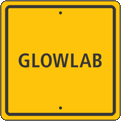
GLOWLAB.04 :: FORGOTTEN and more
GLOWLAB.04 :: FORGOTTEN--Our latest issue is now online, and features some great new projects by Glowlab and guest artists, including:
:: kanarinka--12 Inches of Weather; Weather experiments on the body :: Sharilyn Neidhardt --Into the Groove; Interview with musician and audio archivist Steve Espinola :: Emily Conrad--Lost Phone: 18,900 Google Entries; Lost phone in the back of New York City taxi. Last Friday, around 1am. It must happen all the time :: Sal Randolph--whereyouare; Join in documenting the endangered, lost, or ephemeral beauties of your neighborhood. whereyouare is a participatory experiment, mixing collaborative multimedia, folksonomy tags, and rss feeds to build a portrait of places that matter to us :: Holly Tavel--Xanadu Revisited; Two years on, Xanadu gives up the ghost.
With special guests: Leah Dilworth :: Lost and Found at the City Reliquary; Tour the City Reliquary, Brooklyn's store-front museum dedicated to civic pride and all around good neighborliness; Tianna Kennedy :: On Forgotten, Neglected, and Discarded Objects and Subsequent Utopian Projects Or, the Meandering Story of EV, which recounts the amusing first sally of the ingenious crew as they dragged a thing that had been forgotten from the Bronx to the Lavender Lake; Michele Gambetta :: The Rider Project 2005; The RIDER Project has been created by artists who rent a Ryder Company truck, retrofit it with walls, gallery lights, a generator for electricity, and create a mobile gallery to display art throughout N.Y.C.; Petr Kazil :: Urban Spooklights; Who wouldn't get excited by the appearance of a mysterious light in the distance - in a place where no light is expected?
Glowlab: Open Lab, curated by Christina Ray: A nine-week-long psychogeography festival and exhibition; October 14 through December 11.
Please join us this fall as we head up to Boston for our show at Art Interactive, a non-profit arts space dedicated to contemporary, experimental and participatory artwork.
In Fall 2005, Art Interactive is conducting a nine-week-long experiment. We have invited artists affiliated with Glowlab, a network of psychogeographers, to use the Central Square neighborhood as the site of their research and fill the exhibition space with the results of their investigations. PSYCHOGEOGRAPHY, a term coined by the Situationist International in the 1950s and appropriated by contemporary artists, is used to describe projects that produce affect in relation to the geographic environment. Rather than making maps in the traditional geographic sense, these artists utilize maps and geography to conduct located experiments with (among other things) people, trash, bikes, clothes, the sky and the gallery space itself. Often making use of mobile technologies and existing in the hybrid spaces of the Internet and the physical world, their projects produce new understandings of location and identity as shifting, fluid, singular and irreducible.
Central Square, Cambridge, MA, will never be the same again. Join us for nine weeks of public walks, talks, tours, workshops, concerts, group bike rides, and other ways of exploring the Central Square neighborhood. Each weekend of the festival, different Glowlab artists will be present to lead participatory public events inside and outside the Art Interactive space. Visit the online schedule at http://www.artinteractive.org/calendar for more details about upcoming events or email info[at]artinteractive.org.
Opening Reception: Friday, October 14th, 2005, 6 - 9pm
Gallery Hours & Location: Art Interactive is open Saturdays and Sundays from 12 - 6pm or by appointment. The gallery is located at 130 Bishop Allen Drive, at the corner of Prospect Street in Cambridge, MA. For more information, please contact info@artinteractive.org, call 617-498-0100 or fax 617-498-0019. Press release with downloadable press kit:
http://www.artinteractive.org/shows/glowlab/glowlab_press.html
Posted by jo at 10:21 AM | Comments (0)
August 15, 2005
Roomology

Rooms as Psychogeodynamic Objects
Drinking whiskey laced with vodka can not not produce drunkenness: a room first entered evokes in you an immediate involuntary mental sensation. The human mind senses environments by instinct, scans and evaluates them for properties like ambience, lines of sight and darkness. The horror genre, invented by the partisan architect Horace Walpole, thrived on the discovery that rooms can scare you to death. The grassroots study to this little understood effects of space on mind that transpires through everything humans undertake, as after all you are always somewhere, is called psychogeography.
Psychogeodynamic objects are defined as those blurry-edged entities from which strong psychogeographic 'rays' emanate. The history of landscape representation is one overflowing with anecdotes about the psychogeodynamic demanding its reproduction by the overwhelmed artist or snapshoteer. Roomology, the subdomain of psychogeography that studies rooms as psychogeodynamic objects, can retrace a similar but more covert tradition of artistic studies and observations about the ways rooms and minds work together.
The Gothic Cathedrals are an obvious example of the fact that long before the word psychogeography was invented the thereby described effects were recognised and consciously manipulated to achieve psychological patterns in its spectators. The solitary confinement/sensory deprivation tactic used by certain regimes to put pressure on prisoners is another example of psychogeodynamic engineering in need of urgent analysis from psychogeographic angle.
On a more common level, rooms are ideal environments for the psychogeographers scrutiny because most people have one, and most of them have very precise and immutable ideas of the how their room should look, or to be more precise: should 'feel' like. The vagueness of expression shows the elusiveness of the stuff psychogeographers try to deal with and what makes it the rocket science of poetry.
Roomology and art have a long intertwined history. In her essay "A Room of One's Own", Virgina Woolf explained to woman aspiring to become writers that securing a room for themselves was the one prerequisite they could not do without. Lee 'scratch' Perry's Jamaican studio was called the Ark for a reason. Pictures shows its with leaflets, gear and memorabilia overcrowded walls: conveying the room as a sacramental shrine channelling the bogeyman away from his head and into the record. Perry eventually burnt the Ark down.
The mind-room feedback loop (a psychogeonic system if you like) creates a stream of consciousness that makes it impossible to separate interior design from creative production. Every change in the room indicates/creates/reinforces in many different ways, impossible to untangle, some mental change. The Yellow Room by Vincent van Gogh, the famous painting of his room in Arles with the furniture frenzied by absinthian voodoo, is ample evidence of the fact that artists and rooms are an unbreakable psychological tandem. When Andre Breton during the second world room had to vacate his room, his production faltered dramatically because of it.
Our rooms are part of our intelligence. From notebooks, biographies, diaries and other sources we can analyse the roomologic faculty in others, constant monitoring of our own room-sized spaceship as part of the self is another way to go. Related: The Taxonomy of my Room
Posted by jo at 11:56 AM | Comments (0)
August 03, 2005
Hitching Stealth with Trevor Paglen
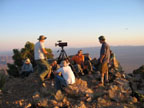
Experimental Geographer
"...Experimental lecturer and all around academic outlaw Trevor Paglen is a new breed of researcher for the University of California at Berkeley. He has been more aptly called by his peers an underground geographer, armed with a telescope, a GPS device, some light field military listening equipment, a car trunk full of cameras and maps, and one hideously nondescript corporate infiltration suit. Swapping between his other outfits as an intervention artist, and investigative journalist, a prison-abolition activist, punkrocker and total sound head, not to mention a third degree master in the art of panoptic trespass, he takes a wildly experimental approach to studying the strategic and practical boundaries of contested public/private space.
Altogether, he's concocted his own strain of what he prefers to call 'experimental geography' that he uses to trace the immense networks of undisclosed borders, shadow lairs and underground finanscapes edified by corporate, state and national defense collusion..." From Hitching Stealth with Trevor Paglen; Text by Bryan Finoki/Photos by Trevor Paglen, Bryan Finoki, & Bill Luoma, Archinect. (2005) [via]
Posted by jo at 10:12 AM | Comments (0)
July 27, 2005
Cracks in the Pavement:
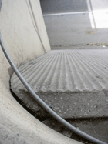
Gifts in the Urban Landscape
Cracks in the Pavement: Gifts in the Urban Landscape is a multi-phased, interactive project that calls attention to the “in-between” spaces encountered throughout everyday life. The project focuses on details within the urban landscape and encourages close inspection of our social space. This summer, artists based in locations around the world will respond to what they find in their urban environments by making art objects designed to be placed in sites that intrigue them—at bus shelters, in alleys, under bridges, in libraries or post offices, or deep in park bushes. Members of the public are invited to search for these site-specific works using maps and clues provided at the web site. Art works featured in Cracks in the Pavement may be kept by whoever finds them. Works not found will be allowed to remain in the landscape indefinitely to be encountered by chance, displaced, or transformed by the very environmental forces that define each piece's context.
The process of discovery lies at the heart of the project. It invites people to engage with their surroundings intimately, encouraging any number of potential encounters or experiences provided in the act of searching. Every environmental detail reveals evidence for an event occurring at a moment in time, as careless and forgettable as roadside trash thrown from a car window or as sublime as the cracks in a building’s foundation caused by an earthquake or tornado. Cracks in the Pavement asks us to ponder where we are in relation to what surrounds us. It calls attention to what we pass by every day, as well as what we leave behind.
Cracks in the Pavement was started in Austin, Texas, in June 2004. The project featured site-specific works by 15 Austin-based and international artists both in Austin and in London, UK and was presented as part of the London Biennale 2004. This year, the project will be launched in multiple phases in different locations throughout summer 2005; click here for a list of participating artists, locations and launch dates. Cracks in the Pavement is organized by Heather Johnson, and will be on view throughout the summer until the last piece is found.
Posted by jo at 07:58 AM | Comments (0)
July 04, 2005
The R.g.b-project
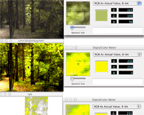
Color Walk-Through
The R.g.b-project--by Jacky Sawatzky--is an experiential project, which invites participants to interact with the city through the concepts of the RGB-color space, a color space commonly used by digital technology. Participants are asked to go on a color-walk through the city, using a video camera to document one of the three colors, Red, Green or Blue. Consequently, the created clip is inputted into a computer program the artist wrote. This computer-program acts, as a surveillance machine through only highlighting what the program 'thinks' is red, green or blue. If the program can't find the specified color, the sound of the clip is heard. Read Jacky's thesis [PDF]
Participants comment on the project as an experience that heightened ones awareness of digital technologies interpretation of color. The results of the project show that this interpretation can be dubious at times. Crucial is the difference in method each participant used while creating the clips. Some had a documentary style approach. Others perceived the instructions as a framework for a performance and some created a conceptual dialogue with the parameters of the computer program. For more information download the thesis on the project page.
Posted by jo at 07:44 AM | Comments (0)
June 30, 2005
Foundcity
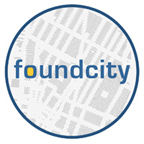
The Dynamic Nature of Place and Space
From The Feature: "...many projects have approached the idea of annotating space before but few have succeeded as well as FoundCity in giving this networked effort a more personal quality. By overlaying the perspectives of thousands of people, FoundCity approaches the dynamic nature of place and space."
Foundcity--by John Geraci, Christina Ray, and John Schimmel--is a social mapping tool for creating a personalized map of your life on-the-fly. Using your mobile phone, you "tag" or capture photos throughout the day, label them with any words you want, and send them to your map. At home, you access and customize your map, which you can share with friends, keep private, or publish openly. As a visitor to the Foundcity site, you view a map of all tags and connect with the people and places that share your interests. By plugging in to the network of Foundcity users, you learn what others value in the city as you surf their hotspots. By publishing your own tags, you share what you know about your city.
Posted by jo at 10:35 AM | Comments (0)
June 16, 2005
Hundekopf
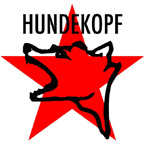
Interactive SMS-story around the Ringbahn
"Stories (...) are like mountain tops jutting out of the sea. Self-contained islands though they may seem, they are upthrusts of an underlying geography that is at once local and, for all that, a part of a universal pattern." - Jerome Bruner, Acts of Meaning (1990)
Hundekopf--by Knifeandfork--is a new project exploring the experience of Berlin's Ringbahn, which encircles the inner city and is used as a literal vehicle to move between time and place in a fiction-historical narrative structured through SMS text-messaging. The Knifeandfork artist group approaches the urban environment as a narrative space - a human artifact constructed of stories both real and imagined that we collectively engage in telling. Hundekopf is being performed at Loving Berlin, June 20-25, 2005.
Posted by jo at 10:47 AM | Comments (0)
June 14, 2005
Review of "A Walk to Remember"
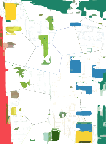
Art on the Outside
Review of A Walk to Remember, Los Angeles Contemporary Exhibitions, February 9 - May 8 2005; Organized by Jens Hoffman, Director of Exhibitions, ICA, London.
The concept of "walking" in the city of Los Angeles conjures up all kinds of cliches and jokes about how "no one walks in LA," and the amorphous qualities so often ascribed to its social and natural geography. Such an impression is easily adopted, as typically one moves by car from one part of town to another, only getting out upon reaching desired destinations or to refuel at gas stations. The language used to describe LA's paved circulatory system belies the indifference to the space that lies between points A and B. On the one hand, there is the web of interconnected freeways that allow one to move from destination to destination, as if in some kind of congested time-space portal, and on the other are the "surface streets," existing at ground level, where daily life plays out.
This February, Los Angeles Contemporary Exhibitions provided access to this surface world through a series of artist-led walks curated by Jens Hoffman of the Institute of Contemporary Arts in London. Titled "A Walk to Remember," the exhibition brings together walks by LA-based artists John Baldassari, Jennifer Bornstein, Meg Cranston, Morgan Fisher, Evan Holloway, Paul McCarthy, Rubén Ortiz Torres, Allen Ruppersberg and Eric Welsey. Participants on each of the walks will be given a disposable camera with which to document the event, with the results being displayed in LACE's exhibition space.
Of course, walking already has established historical ties to performative and conceptual art practices. Richard Long and Andy Goldsworthy's formal traversals into the non-urban, the illegal border crossings of Christian Philipp Müller and Heath Bunting, and the urban derivés of the Situationists are but a few examples of the aestheticization of bipedal transportation. The LA Times recently celebrated LA's own amateur walkabout, an engineer named Neil Hopper, who documents his extensive hikes around the city on walkinginla.com.
The descriptions of the walks hosted by LACE range from a leisurely walk below the Hollywood sign in Griffith Park (Bornstein and Wesley) to a trip to Sherman Indian High School, one of three remaining off-reservation Native American boarding schools in the country (Cranston). Fisher and Ruppersberg set out to explore the intersections of personal and collective memory in the ever changing urban landscapes of Santa Monica and Hollywood, respectively. There are also "instruction" pieces, where walkers are asked to either photograph all the street signs from Baldassari's studio or perform their own walk ten consecutive times, per McCarthy¹s request.
By the time of this writing, this writer was able to attend the first two walks - Ortiz Torres' trip to El Pedorrero ("the farter"), a muffler shop and museum in East LA, and Holloway's walk from his studio near MacArthur Park. The tour of El Pedorrero, an ultra baroque environment shaped by the imagination and efforts of its owner, known as "Bill Al Capone," revealed an aesthetic vision of the "American Dream" that recombines both the utopian and vulgar aspects of modernity into one seamless architectural space. Holloway's walk from his studio to the Alvarado/7th St Metro Station, in an area known for gang activity and the infamous LAPD Rampart Division scandal, is the only walk that explicitly offers danger as bait to participants. The artist even pointed out the location where he was mugged almost three years before.
Art that involves any sort of interaction with a community, outside of its own, has been the subject of a fair amount of criticism from wildly different perspectives. "A Walk to Remember" may not situate itself as a form of "community art," but it certainly shares more than a few concerns and formal strategies. It may be worthwhile, then, to reexamine Hal Foster's critique of the ethnographic urge found in some site-specific art of the previous decade. The slippages Foster found between artists' identifications with an "outside" and the ability of institutions to assimilate those identities seem an appropriate area of inquiry for current work also dealing with an "outside." In presenting this exhibit, LACE painted one of their rooms to resemble a blank landscape - the walls split by a horizon line separating blue and green fields - which are decorated with maps of the artists' walks and photos documenting them. Perhaps, the artist-as-ethnographer is not the model found here, as any specific identities play only a secondary role. Like much current site-specific art, emphasis is placed on spatial understandings of history and urban geography - with maps being the formal device of the day. The concerns of urban planning and real estate seem to have replaced those of anthropology, as we've learned that identities are only as valuable as the land they occupy.
- Ryan Griffis [for Rhizome]
Posted by jo at 08:16 AM | Comments (0)
June 03, 2005
Significant Sites - a Summer Solstice Dérive
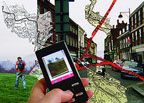
An Invitation to Participate
Significant Sites-a Summer Solstice Dérive is inspired by the Situationist practice of dérive. John and Cathy Rogers set out to chart the layers of place that make up High Wycombe as it undergoes a period of transition and redevelopment. After conducting and initial period of investigation through a series of dérives and interventions they intend to stage a grand psychogeographical event on June 18, 2005 during the Summer Solstice.
A Walker will embark on a ritualistic perambulation to link up the significant sites, or Nodules of Energy that surround the town. He will use the town's matrix of ancient footpaths to achieve this circuit. Using a videophone he will send moving images to a base station in a prominent position in the town centre where they will be projected onto a screen where spectators will be able to watch the walk as it happens.
The relayed image of the walker is presented alongside a montage of archive film and present day photographs of the town together with a simulated image of the town. In addition to the video clips the walker will send reports from his location via voice and text messages.
Spectators will be able to interact with the walker giving him directions to places they consider to be significant sites and furnish him with information and folklore about the areas he walks through.
People will be encouraged to set out on their own dérives and send back images and text to the base station for projection and relay to the audience.
Posted by jo at 02:14 PM | Comments (0)
June 01, 2005
Selkirk:
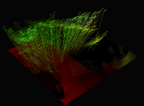
Jabberwocky Cartography of/as a Little Mind
"The moment you step into a room an ancient process of mind, functioning beyond intent and language, faster than your internal clock can say tick, will evaluate it and evoke in you a qualitative sensation. Psychogeography is the non-academic study of the way these properties of spaces are able to produce in people distinct behaviour. Scientific fact is scarce but folklore, art and literature of all times provide us with a surplus of intuitions and observations about landscape making man and not the other way around. As manmade environments, cities are of interest to psychogeographers as here the psychogeographic effect is operating in the most obvious recursive mode: the landscape designs the designer of the landscape and so on in dense concentrations of place and time." From Selkirk: Jabberwocky Cartography of/as a Little Mind by Wilfried Hou Je Bek and Orkan Telhan. Read full paper >> [via angermann]
Posted by jo at 11:50 AM | Comments (0)
April 28, 2005
Theatre/Archaeology
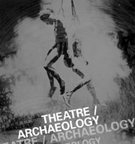
Places Which Perhaps Only the Poet Can Map
"We begin to walk. We feel the ground beneath our feet, the wind in our face. And as we do, we leave traces. We are involved in the landscape. We leave the prints of our body, the touch of flesh on metal and stone. We constantly wear things out, with our hands, our feet, our backs, our lips. And we leave the traces of singular actions: the unintentional, the random, the intimate, unplanned touch of history's passing: we break twigs, move pebbles, crush ants... all the signs that trackers learn to read... And we discard things - we throw things away, we lose things - material which, in years to come, others will regard as artefacts, as the remains of past actions...
We begin to create a palimpsest - writing over writing over writing - in a kind of stratigraphy of text. Perhaps we became frustrated and threw it away, a love letter that wouldn't compose itself. But as we retrieve it, we realise something unusual. Points which were once separated in time and space are now adjacent, in a new non-linear relationship... We try to straighten it out. But of course we can't. It has developed a kind of topography of creases, bumps, rips, all of which will now influence how we might move across it... Different paths enact different stories of action...
It is the matrix of particular folds and creases, the vernacular detail, which attached us to a place... In these notions, landscape is not separate from the lives lived there. But they are not... precise territorial zones, rigorously defined, delineated and patrolled... This is slippery ground, places without firm boundaries, places which perhaps only the poet can map."-- Mike Pearson and Michael Shanks' Theatre/Archaeology
See also: Walking as Knowing as Making; Deep Mapping; Archaeologically speaking... [blogged by Anne Galloway on Space and Culture]
Posted by jo at 07:24 AM | Comments (0)
April 26, 2005
Provflux 2005
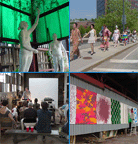
Implementation to be Featured
"Nick and I recently got word that Implementation has been accepted by Provflux 2005, both as an Intervention (live event) as an exhibition. Implementation’s second gallery exhibition will take the form of mounted photos from the project, a DVD of distance shots, and take-home sticker sheets on display at CUBE2 Gallery in downtown Providence, Rhode Island from May 19th until the end of the month, and we’ll be in Providence May 27th-29th for the event itself, with a goal of distributing, placing, and documenting the entire novel in one weekend in one location. Bring your digital camera and camping gear if you want to join us. Implementation joins about 50 other public interventions, games, urban exploration, lost space recovery, and tech mapping projects for this fluxist/situationist/public art happening." [blogged by Scott on grandtextauto]
Posted by jo at 09:10 AM | Comments (0)
April 25, 2005
Walk Los Angeles With Me
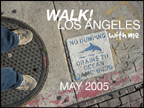
In Search of Poetry
"Hello Friend,
On Sunday 15th May, at noon, I'm setting out of my house in Echo Park, Los Angeles, and not returning until I've walked the whole of L.A. I'm going to trek the city of Los Angeles like an explorer charting uncharted territory. And I'm going to be stopping people on the streets and inviting them to walk with me too - and videoing what happens when they do from a video camera attached to a baby stroller I'll be pushing around with me. The footage from that, along with photos and writing, will be regularly updated into a video blog while I'm on the road and later compiled into a film of what LA revealed itself to me as when I stepped out of the bubble of my car, my tv and my preconceptions.
Basically, I'm looking for poetry where it's often easiest to miss it. Please check out my website!" [via city of sound]
Posted by jo at 12:31 PM | Comments (0)
April 20, 2005
9PIN

Mapping the SCAN Community
In summer 2003, a call for artists was sent out for the project 9PIN. The call asked artists to respond to the (then) 9 geographical locations occupied by the consortium members of SCAN. Proposals were submitted for a series of residencies and commissions looking at the possibilities for networking and mapping in the SCAN community. James Coupe, Hedley Roberts and Rob Saunders, Hywel Davies, Armin Medosch and Ivan Pope were chosen because of their range of inventive approaches to the SCAN network.
From Armin Medosch’s data visualisation research starting with a comparison between real and virtual ports through to Hywel Davies’ compilation of a sound database, gathered from each of the consortium venues, for the composition of new material by both himself and other musicians and composers, each of the artists involved in 9PIN makes a significant contribution to their own areas of practice and dissemination of content, whilst helping SCAN to cohere a very disparate group of organisations brought together by their desire to collaborate on high quality experimental work.
Ivan Pope brings his sketches and ideas using GPS, to enhance his interest in psychogeography, to his workshops, while James Coupe and Hedley Roberts take on the difficult task of examining and building an intelligent system which reflects activity (data drawn from sensors installed at SCAN’s member organisations) at each venue in the SCAN network.
The 9PIN project is premised on research and development and brings together artists and makers who are at the forefront of their field. This is a flagship project for SCAN and sets a precedent for the organisation’s aspiration to facilitate an environment for practitioners to develop their process outside of other areas of institutional research whilst working towards high quality outputs for the SCAN network.
SCAN is the innovative new media arts agency in the south of England. As a network of organisations, SCAN is committed to the delivery and facilitation of collaborative works.
"SCAN presents a unique model of networking across a number of diverse arts organisations in the south of England. We commissioned the 9PIN project to explore the network and build a model for SCAN as a whole. We invited artists with an interest in data analysis and mapping to produce a body of high quality work. They have come up with some extremely creative interpretations of the commonalities and differences across the organisations in the network"- Helen Sloan, Director of SCAN
The aim of 9PIN was that each artist should make a significant contribution to their own area of practice, whilst helping SCAN to make connections between the disparate group of organisations that constitute the SCAN network. 9PIN is a flagship project for SCAN and sets a precedent for the organisation’s aspiration to facilitate an environment for practitioners to develop their process outside of other areas of institutional research whilst providing high quality outputs for the SCAN network.
Posted by jo at 09:50 AM | Comments (0)
April 19, 2005
Parking Public
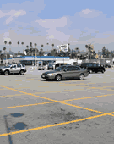
A Clash of Desires
With Parking Public, The Temporary Travel Office explores the largest openspaces around Hollywood Blvd, privately owned parking lots. The Travel Office is also interested in the relationships between the utopian spaces we all desire and the not-so-utopian spaces we end up inhabiting. This clash of desires and social realities is especially present in Hollywood, one of the centers of global utopian myth making. In order to bring these two worlds together, fantasy and reality, the Travel Office is distributing flyers on the windshields of parked cars soliciting answers to the question "what is your utopian destination?" By calling a phone number provided on the flyer, participants can leave a message describing their
dream locale, which is recorded on an audio blog. Because of the global network of influences on ideas of the utopian (those of us in the US often describe a tropical setting based on postcards and movies) as well as our material environment (the international distribution of goods and services), the survey is also open to people residing outside of Hollywood. The results of the survey are displayed on the web as they come in. A map of private parking lots and images from a walking tour are available on the site as well.
Posted by jo at 10:19 AM | Comments (0)
March 30, 2005
Theory of the Dérive

Drifting and Chance
"One of the basic situationist practices is the dérive [literally: "driftingî], a technique of rapid passage through varied ambiances. Dérives involve playful-constructive behavior and awareness of psychogeographical effects, and are thus quite different from the classic notions of journey or stroll.
In a dérive one or more persons during a certain period drop their relations, their work and leisure activities, and all their other usual motives for movement and action, and let themselves be drawn by the attractions of the terrain and the encounters they find there. Chance is a less important factor in this activity than one might think: from a dérive point of view cities have psychogeographical contours, with constant currents, fixed points and vortexes that strongly discourage entry into or exit from certain zones." From Theory of the Dérive by Guy Debord.
Posted by jo at 04:24 PM | Comments (0)
Visitor.Files

Observer and Observed
"Is it possible to be a stranger in your own neighborhood? The Visitor.Files project--by Christina Ray--originated with a wish to replicate the heightened awareness commonly felt when first landing in a foreign city, when every person, sight and smell appears curious and full of potential. For this project, I attempt to become a temporary visitor even in the most familiar of locations.
Visitor.Files documents the common flow of city sidewalk activity with multiple media and translates the recorded observations into a visual code presented as a series of hand-drawn maps." Continue reading >>
Posted by jo at 08:40 AM | Comments (0)
March 28, 2005
teletaxi
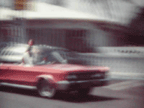
Car #235
Year Zero One is pleased to present teletaxi, a site-specific media art exhibition in a taxicab. The taxi is outfitted with an interactive touch screen that displays video, animation, audio, and information triggered by an onboard GPS (Global Positioning System) receiver which allows the displayed artwork to change depending on where the taxi is in the city. With the combination of the media/gps technology, the mobile environment and the passenger/audience inside the cab. The eleven artists in teletaxi are offered a unique set of possibilities for showing their work - both technically and thematically.
teletaxi will expose interactive media art to a normally passive audience, by presenting works that explore notions of intimacy, mapping, subterranean space, simulated cities, information architecture, data-visualisation, public interventions, surveillance and psychogeography.
Presented by Year Zero One, in Montreal, from March 21 to June, 2005. As part of the DIS/LOCATION: projet d'articulation urbaine programming of DARE-DARE Centre de diffusion d'art multidisciplinaire de Montréal.
Michael Alstad; Mario Côté; Milutin Gubash; David Jhave Johnston; Patric Lacasse; Virginie Laganière; Valérie Lamontagne; Éric Raymond; Doug Scholes
Camille Turner; Myriam Yates.
Opening Friday April first, from 5PM to 9PM, at Square Viger.
Join us at Dare Dare (Square Viger) for a 'fare free' ride in the teletaxi to navigate some of the neighbourhoods and Montreal sites explored by Year Zero One artists and guests.
To reach Taxi Co-op of Montréal, call at (514) 725.9885 and ask for car #235; For more information, contact Dare Dare at (514) 878.1088
[Related]
Posted by jo at 12:54 PM | Comments (0)
March 23, 2005
Crosswalk
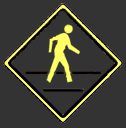
Urban Action
Crosswalk --a Providence Initiative for Psychogeographic Studies (PIPS) publication--is dedicated to further investigations in psychogeography, experimental public art, critical architectural theory, and all practices inbetween. Crosswalk v1.1: Psy-Geo Provflux 2004 was published to coincide with the first annual Psy-Geo Provflux, a two day event investigating how the urban landscape in Providence (Rhode Island, USA) affects its social and artistic community. A call has just been issued for Psy-Geo Provflux 2005.
Crosswalk v1.2::Space Ships includes "Collective Practices," "Interventionist Diaries," "Contemporary Nomadism," "Free Culture," and "Public vs Private."
Posted by jo at 09:57 AM | Comments (0)
March 11, 2005
The Shape of Locative Media
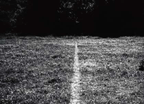
Mute, Locative Media and the End of Suburbia
The Shape of Locative Media, by Simon Pope MUTE 29:: 9.02.05.
"...(W)hat I found most interesting in this article is the focus on spatialising practices, tactics and strategies. He draws out an interesting tension between locative media projects working on a tactical level by resisting 'official' histories (through, for example, public authoring) and at the same time being implicated in institutional strategies of funding, research and development. He also points at tensions between Situationism, especially psychogeography, and Conceptual art as they may play out in locative media projects:
"There’s a wilful skimming of the surface of psychogeography, taking it to mean an unconstrained movement in the streets, and apparently less of an alignment with the wider project of anti-urbanism. This can leave an impression of a practice whose relation to ‘the city’ is closer to the disinterestedness of Conceptualism than the supposed engagement of the SI...[Situationist] devices for mapping the interactions and perceptions of human desires onto Paris, for example, were driven not by chance, as were the preceding scorned Surrealist interventions, but rather as a direct and conscious operation on the city..." [blogged by Anne Galloway on purselipsquarejaw]
The map, for Conceptual artists, seems more useful as a simple, generic method for recording the spatial aspects of a sculptural practice on an expanded scale...This leaves me wondering how those developing locative media understand themselves to be implicated in the spaces that they construct, record and annotate..."
This certainly resonates with my own wondering about how Situationism is being applied to locative media and pervasive computing. I have noted in the past that I'm troubled by the use of superficial Situationism to justify playful design practices rather than for socially and culturally critical approaches to technology and urban life. I've also expressed bewilderment at the lack of discussion about how the structure of GPS, absolute positioning, computing algorithms etc. actually conflicts with more fluid (social and cultural) understandings of spatial experience..." Anne Galloway
Posted by jo at 08:02 AM | Comments (0)
March 09, 2005
Dérive=Drift
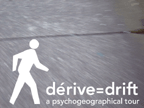
A Psychogeographical Tour
"(In Dérive=Drift: a Psychogeographical Tour) six subjects engaged in systematic derives. (A term coined by the French Situationists that translates, 'to drift'.) The subjects went on walks around the neighborhood of SE Belmont in Portland, OR. The focus of the trip was on the journey, and as such no destination was set. The subjects recorded their observations and emotions, using the PML model as defined by socialfiction.org.
The following demonstration is a collection of their experiences. It aims to create a new map of the city, based on the collective experience of those that inhabit it."
Posted by jo at 12:33 PM | Comments (0)
March 07, 2005
Project Research and Software Toys
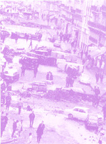
Miscellaneous
"...Situationist International Online: I’ve spent some good hours here recently. The situationists were anticopyright from the beginning, which has made this quite extensive archive of texts from the situationist movement which reached its height in the 1960s possible, including a complete archive of Internationale Situationniste and Guy Debord’s Society of the Spectacle.
Building a Mobile, Locative Collaborative Application: Documentation of the development of CatchBob, a treasure-hunt type, Wi-Fi based locative and collaborative mobile game. The game itself is fairly simple in concept:
The aim of the game for the participants is to find a virtual object on our campus and enclosing it in a triangle formed by their position. The positions are provided by a location-based tool running on a PocketPC or a TabletPC. This tool allows each person to see the location of his or her partners as an avatar on the campus map. Another meaningful piece of information given by this tool is whether the user is close or far from the object: an individual proximity sensor.
Lumiere Ghosting in the New Media Classroom: David Gillette describes a new media curriculum built around Lev Manovich’s The Language of New Media, and its focus on new media development as a form of interactive, multicultural cinema, and using a Cave-like display, the CompuObscura, an interactive new media art work that allows viewers to interact with images on display inside the device.
Jim Bugardner: the guy who invented the Palace avatar based chat system in the 1990s, has lots of generative art, doodads and neat little software toys at this site.
iStory Creator: an application made to allow people the opportunity to create their own iPod text games of the choose your-own-adventure variety."
[blogged by Scott on Grandtextauto]
Posted by jo at 11:07 AM | Comments (0)
February 28, 2005
Towards an Emotional GPS:

Writing Your Own City
"...Psychogeography and cognitive mapping offer two suggestions for recording wireless experiences, using a term we've coined, emotional GPS. Whereas traditional GIS (Geographic Information Systems) and GPS (Global Positioning Systems) tend towards an empirical representation of the world, emotional GPS is biased towards the personal, temporary, and imaginary. In most cases, the prevailing impact of wireless on the definition of a place is not so much on its static form as the potential experiences that this place can afford. The wireless environment provides an alternative use, an augmented interface, or new associative mnemonics. Providing an annotative mapping framework, use of emotional GPS fosters a networked mobility within these environments that undermines the authoritarian bent of traditional GIS and GPS mapping techniques." From Towards an Emotional GPS: Writing Your Own City by Scott Paterson, with Marina Zurkow and Julian Bleecker, Intelligent Agent, Vol. 3 No. 2.
Posted by jo at 10:52 AM | Comments (0)
February 25, 2005
Taxi_onomy
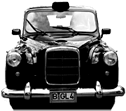
The Ultimate Vehicle for Psychogeography
Taxi_onomy, by Celine Condorelli and Beatrice Gibson, is an urban mapping project and mobile cartographic research endeavour that seeks to re-appropriate the black taxi as the ultimate vehicle for psychogeography, based on its capacity for metro processing and spatial understanding. Tax_ionomy will utilise the black taxi for the purposes of enabling artists and the general public to create and utilise emotional, cognitive and networked maps of the city.
Taxi_onomy - a live art project to take place in a taxi; the practice of classification from the purview of the taxi. Mumbai, a Taxonomy of the City is now available to view on line.
Posted by jo at 01:15 PM | Comments (0)
December 31, 2004
Psychogeography and Imperial Infrastructure
Psychogeography and Imperial Infrastructure, by Brian Holmes, Springerin.
Great social movements leave the content of their critical politics behind, in the forms of a new dominion. This was the destiny of the revolt against bureaucratic rationalism in the sixties. The Situationists, with the practice of the dérive and the program of unitary urbanism, aimed to subvert the functionalist grids of modernist city planning. They tried to lose themselves in the urban labyrinth, while calling for the total fusion of artistic and scientific resources in »complete decors« –»another city for another life«, as the radical architect Constant proclaimed. With the worldwide implementation of a digital media architecture – and the early signs of a move toward cinematic buildings – we are now seeing the transformation of the urban framework into total decor (Lev Manovich: »In the longer term every object may become a screen connected to the Net, with the whole of built space becoming a set of display surfaces«. What kind of life can be lived in the media architecture? And how to explain the continuing prestige of Situationist aesthetics, in a period which has changed so dramatically since the early 1960s? Continue reading >>
Posted by jo at 10:02 AM | Comments (1)
December 29, 2004
Questioning the Frame
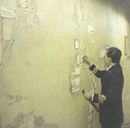
Thoughts about maps and spatial logic
"...Terms such as "mapping," "borders," "hacking," "trans-nationalism," "identity as spatial," and so on have been popularized in recent years by new media theories’ celebration of "the networks"—a catch-all phrase for the modes of communication and exchange facilitated by the Internet.
We should proceed with caution in using this terminology because it accords strategic primacy to space and simultaneously downplays time—i.e., history. It also evades categories of embodied difference such as race, gender and class, and in doing so prevents us from understanding how the historical development of those differences has shaped our contemporary worldview.
..." Read full article Questioning the Frame: Thoughts about maps and spatial logic in the global present by Coco Fusco, In These Times, December 16, 2004. Responses to the article culled from Locative and nettime:
Responses to the article culled from locative and nettime:
Date: Thu, 16 Dec 2004 22:26:27 +0000
From: Pall Thayer
Subject: [Locative] Questioning the Frame
To: locative@x-i.net
hmmm.... I just wish she would mention some of the mapping projects she's talking about. She really seems to have a narrow understanding of what artists are doing with locative media. She seems to suggest that one of the problems is that the artists have too much control over the social picture that the maps portray. And other artforms don't? I'm going to have to read this through a couple of times to make sure I really understand what she's saying but after a couple of scans it really looks rediculous and I almost get the feeling that she regrets not being a "hacker".
Pall
Ewen Chardronnet wrote:
well, she always comes with interesting art critics and post-colonial discourses, but use same dialectics each time. I remember reading same dialectics in her critics on "art and science" hipe and "critical art ensemble trial" hipe. And now the "locative media" hipe... You can be sure there will be a critic on "pervasive arts" and "space arts" soon, etc. and of course better if those arts are done by white male artists
E.
Date: Thu, 23 Dec 2004 17:08:14 +0100 (CET)
From: Brian HOLMES
Subject: [Locative] A Reply to Coco Fusco
As a critic it's important to read your peers, and try to assess the pertinence of your own work in the mirror of theirs. So I was curious to read Coco Fusco's recent article on mapping [www.inthesetimes.com/site/main/article/ questioning_the_frame]. However, I must say that her continuous assertions of cultural authority leave me feeling highly ambivalent. On the one hand, the threads of historical memory she brings up are extremely welcome. On the other, her unwillingness to engage with current conditions and projects tends to reduce the past to a complaint: Why isn't it the present anymore?
It's true that the raw fact of being older than the majority of the people in a given crowd can make you feel uncomfortably lucid. When I went to a conference on so-called "locative" or GPS-based media at the RIXC center in Latvia, I found most of the projects quite naive, developing a few stylistic traits of situationist psychogeography in the absence of any geopolitical critique of power relations, or any philosophical critique of instrumental rationality. In effect, a Cartesian worldview has been built into the computerized technology of graphic information systems, which are undergirded by megaprojects of military origin, or what I call "imperial infrastructure." But rather than just giving a disciplinary lecture with all the answers stated in general terms, I tried to show how changing conditions had made the once-subversive traditions of psychogeography quite superficial, to the point where the aesthetic forms the artists were using seemed to render the very infrastructure of their projects invisible. And when I recently published that paper out of context in Springerin, I took the time to name all the artists and projects in question, so as to establish the precise referents of the critique [springerin.at]. I wish Coco Fusco would make that kind of minimal effort, as it would bring her sharp observations into contact with actual projects, and open up a space of possible transformation.
More to the point: When I began my work on mapping, about four years ago now, as a direct result of involvement in demonstrations against the policies of the WTO and IMF, I too felt that the most important reference was the history of the Third World movements of national liberation, in their relations to the Western civil rights and new left movements of the 60s and 70s. In an early text that was finally published in the book Moneynations, I tried to show how the very concept of the Third World, and then above all, the reality of the Movement of Non-Aligned Nations, acted to open up new imaginary and real spaces within the dominant bi-polar map of the Cold War [http://2002.memefest.org/en/defaultnews.cfm?newsmem=15]. I asked the question whether the emergence of the World Social Forum in Porto Alegre could be compared to the Bandung Conference in 1955. Obviously, the answer was that it could not: both because the current antisystemic movements do not (yet) have the strength that Bandung represented, and because the operative modes of opposition may well have changed fundamentally since 1955.
The global importance of the Third World movements lay in the new kinds of international solidarity that they helped provoke. But something important remains unstated in Fusco's references to these movements, and this is the fact that the major links that tied them to the First World do not exist anymore (nor, indeed, do the movements themselves, for we are talking about specifically national movements in the period of decolonization). One of these links was an aspiration to create a non-Stalinist form of communism, according to the examples given by the successful Cuban and Vietnamese guerrilla insurgencies, and also by Yugoslav self-management (one must remember that the non-aligned movement came officially into existence in Belgrade). Another powerful link was the notion of cultural authenticity, or inherent difference from the Western norm, as a liberating foundation upon which newly independent nations could be built. This Third World concept served as a basis for the struggles toward a multicultural society in the First World. Today, however, the egalitarian aspiration to a self-managed communism has no objective touchstone in reality, leaving those who feel its lack in a deep state of ideological disarray. At the same time, the notion of cultural authenticity has been largely usurped by nationalist or fundamentalist projects which, although they have fortunately not eradicated all work towards equal rights in a multicultural society, have nonetheless made it very difficult to raise the banner of cultural or ethnic difference as a rallying-point for international solidarity.
Instead of relying on the old internationalist slogans (Third Worldist or proletarian), the transnational movements of dissent that gathered strength throughout the 1990s tried to use the communicative power of the discourses of human rights that had gained currency in the 80s, largely through the resistance of people in the former Eastern bloc to totalitarianism, and in Latin America to dictatorship. It was subsequently necessary, in the late 90s, for the Western participants in these transnational movements to take the further step of putting their own bodies on the line, of taking direct action against the international economic institutions, in order to go beyond the abstract character of the human rights discourse. This was a way of responding, in the overdeveloped countries, to the sacrifices of the many "IMF riots" that had been held, often at great cost of life, in what was now being called the Global South. Anyone who believes this step was taken by middle-class white kids acting on internet fantasies, in the absence of direct input from social movements around the world, quite obviously didn't go to any of the demonstrations and paid no attention to the planning process or the reports.
The point, however, is not to suggest that a brief flare-up of worldwide protest has brought about any substantial change. It is rather to recall what a difficult and long-term effort is really needed, both to grasp the way that transnational state capitalism now functions, and to articulate large-scale resistance. When Josh On [www.theyrule.net] or Bureau d'Etudes [http://utangente.free.fr/index2.html] make their complex charts of contemporary power relations, one can be assured that the cold and abstract character of the results is very painful to them. I can testify, particularly in the second case, that they are acutely aware of what is missing from such documents: namely, some affective indication of resistance from below, who does it, how they work and why. What has been achieved in such cartography projects, however, is a contribution to the very large-scale effort to rebuild a critical grasp of the oppressive forces that create the dominant map of the world. This kind of power-mapping is a necessary prelude to any effective resistance or counter-proposition. The fact that the difference between such efforts and the current military maps used by the Pentagon does not appear clearly on American TV is hardly something you can blame the artists for! There is a difference between general culture critique and constructive critique directed toward people carrying out specific projects.
Somewhat like Coco Fusco, I often wonder why contemporary artists appear so broadly unable to infuse the dominant map with representations of - or even better, direct links to - the many and diverse dissenting groups and alternative philosophies that are now emerging in the world, or that have remained active over decades. Unlike Coco Fusco, however, I don't think it's useful or necessary to berate artists today for not having been born earlier. The great philosophical frameworks of national liberation and egalitarian self-management that were able to articulate far-flung resistance movements in the past are inoperative in our time. The urgency is for real individuals of all generations, on all continents, to put their heads and hearts together and create new articulations. The specific job of writers and organizers is then to give those articulations conceptual clarity and popular currency, so that they can effectively challenge the absurd world-views presented on American TV.
As to artists, for whom the naked power structures of the contemporary world must now be quite visible, I encourage them to delve more deeply into the diverse efforts that are being made to resist the imposition of a homogeneous control structure on the entire world. This requires looking outside the boundaries of class, ethnicity and nationality, as certain artists and intellectuals of previous generations effectively did. To live up to the great examples of the past then means imagining something quite different for the future. Need it be said that certain kinds of imagination can serve as the first steps towards a transformation of reality?
Date: Fri, 24 Dec 2004 04:13:32 +0000
From: Saul Albert
Subject: Re: [Locative] A Reply to Coco Fusco
To: Brian Holmes
Hi Brian,
I read both Coco Fusco's piece and your response with interest and a little bemusement. You addressed the lazy generality of CF's rant very well, and touched on a couple of things that provoked me to write back:
Firstly, can we please get away from technological determinism?
Yes, the use of military-industrial technology can be problematic, but that criticism in your text is as widely and as targetlessly applied as Coco Fusco's. Many people are using these technologies (GPS/mobile phones/internet/high-tech gizmos), the social movements that you use as your reference points as much as anyone. In fact, it's not like we really have the choice about using these technologies , being subjects in a technocracy... and it's only out of the appropriation and reuse of these technologies that critique can form and attempt to reconfigure the social and political relations that produced them in the first place. Even on a non-technical level, using these technologies and observing their effects and deployment has been instrumental in the development of a number of political discourses: information and affective labour, precarity, [cyber]feminism etc. The critique develops as much from practice as practice develops from critique.
example: London Free Map - http://uo.space.frot.org/?node=LondonFreeMap
http://chinabone.lth.bclub.org.uk/albums/misc/london_free_map.sized.jpg
Jo Walsh and Schulyer Erle have been working on the 'London Free Map' This project encourages participants to walk, drive, cycle or skate through city streets with GPS units and then use the 'traces' of points representing latitude and longitude that these devices generate to help create publicly licensed geodata. They are also working on adapting existing open source software to enable people to annotate and extend these maps in a very flexible way. The example linked to above shows straight lines representing GPS traces made wandering the streets of Limehouse, East London, an area undergoing a huge urban regeneration process in preparation for the proposed Olympic games in 2012. The labeled points are the locations and names of approved planning permission applications made to the London Borough of Tower Hamlets in the last five years, automatically retrieved from the council's website and plotted onto a scanned out-of- copyright historical map of the area from 1916. This is just one potential use of the London Free Map, a way of visualising physical and historical changes to a space undergoing a huge social and economic upheaval. The potential for further uses and the development of new, as yet unimagined maps from this project seems evident.
Secondly, I found the distinction between these technologically specific, less overtly political projects, and the 'power-mapping' practices of (the wonderful) Bureau D'Etudes and many many others to be a bit thin. I know you share their frustration at having to use the language of power to map power, but the problem is not just in the inability of this form to represent the fertile heterogeneity of the social movements. 'Power mapping' deals in the currency of power, and its representational structure can reinforce the dynamics of the relationships it represents. More worryingly, the unnerving coherence of these representations can also become ised easily - the currency of power made visual, or (worse) 'data visualisation' knits neatly into artistic and authorial currencies and relationships that can become as reactionary and totalising as the military-industrial technologies you were warning against earlier.
I know you know this, your descriptions of the playfulness of the Bureau's maps illustrates the path they choose out of this bind : 'solidarity with aliens'. But people using similar or derivative techniques seem to embrace the solemnity and darkness of their maps without having the escape pod provided by their humour.
What encourages me about initiatives like the London Free Map and many of the projects in the orbit of the 'locative media lab' is that they often work, on a very basic level, to avoid totalising representations. To some extent this is emerging as an informal agreement on technologies, open Semantic Web standards and other esoterica that I'm not really equipped to explain. Also, many of these projects are based on public workshops, working with people and groups on producing representations of themselves, spaces, movement and relationships. Of course none of this is inherantly interesting. Public workshops and 'open' technologies carry their own wealth of dead ends, vices and travesties, but they certainly are politicised - and politicising, in a very different and more subtle sense than that of 'power maps'. The contingency on input from the map-users is the most obvious distinction between these forms of mapping and the two examples of 'power mapping' you mentioned. Of course this aspect of 'participation' in the making of the map is just as worrying in terms of which currencies it evokes, auteurship and the 'framing' of 'public use' in the interests of pseudo-ehthographic artistic value creation etc. etc.. But the locative media lab's engagement with corporations, the way some of it is like cheap corporate R&D in exchange for getting to use fancy devices, the links with 'community groups' funded and instrumentised by arts bodies, and with governments for use of geodata is all messy, difficult, and suspect, but necessary if the technology, and the discourse are going to develop.
This probably warrants more examples, which I'm too tired to start with now.
I guess the problem is that criticising something is difficult because you have to explain why, whereas blithering pleasantries about things you like is not so demanding.
keep up the good work brian!
X
Saul.
Date: Sun, 26 Dec 2004 23:48:54 -0800
From: John Hopkins
Subject: Re: [Locative] A Reply to Coco Fusco
To: locative@x-i.net
>>Firstly, can we please get away from technological determinism? Yes, the use of military-industrial technology can be problematic, but that criticism in your text is as widely and as targetlessly applied as Coco Fusco's. Many people are using these technologies (GPS/mobile phones/internet/high-tech gizmos), the social movements that you use as your reference points as much as anyone. In fact, it's not like we really have the choice about using these technologies , being subjects in a technocracy... and<<
Why no choice? If no choice, isn't that technological determinism to the extreme degree?
It is an incremental process -- each mile you drive onwards in your fossil-fuel burning device, or crank open the thermostat in the house, that drives the social system further onward in its dominance. (it propels the US military machine a bit further in its desparate mission to secure the true power/energy-base of the social structure that is is an integral part of). each time you don't do those things de-poweres that same system.
each time you watch one minute of centrally organized media you give that structure more power. each time you cross social-structural boundaries and engage an Other human directly, you depower those ordained structures.
hmmm.
JH
Date: Mon, 27 Dec 2004 11:32:20 -0000
From: "Armin Medosch"
Subject: Re: [Locative] A Reply to Coco Fusco
Hi Saul, Hi Brian,
let me first make some sort of disclaimer: I am happy that Coco's article (which I have not read, but can roughly imagine what it contains) triggered this discussion about locative media which was long overdue. I think many people have felt uncomfortable with the unarticulated political 'content' or 'meaning' of locative work but have not spoken in public. One reason for that might be that they felt, as I did, that there is a lot of potential in that field and that the (mostly young) people involved did not deserve to be bashed for all their good intentions, even though those intentions sometimes gave relatively weak results. Finally the lid has been blown off and that is a good thing. I now do neither want to argue for or against Saul or Brian but just throw in my two-pence. I also have to say that writing something really meaningful about that whole area would take at least a day and I simply don't have that time right now. So please excuse the immaturity of my words which are quickly written in a sort of email improvisation which I guess was once the spirit of internet discussions which is now often sadly missed.
Saul said at the very beginning of his reply:
>> Firstly, can we please get away from technological determinism?
What does this statement mean? It is indeed important to 'get away from technological determinism'. But what this statement should not mean is that we should not consider or discuss technological determinism.
Saul continues:
>> Yes, the use of military-industrial technology can be problematic,
I would go further and say that 'can be problematic' is not strong enough. It _is_ problematic, always. The instrumental power that is contained in those technologies is a central issue of our time, and by 'our time' i do not only refer to the last couple of years or so but to the last 50 or even 100 years. Therefore I think such statements about technological determinism and military-industrial technology should not be used to quash any discussion about those issues. Those issues should exactly be the starting point of any discussion about 'locative' projects and indeed media art and net art projects. This is where the media art community has failed over the last 20 years which I was able to witness as a grown up person. It is one of the big failures of that community and possibly one of the reasons why it made so little real progress over that period of time. When I say 'real progress' I of course don't mean technological progress, of which we have seen plenty, but a progress in the social use of those technologies, in their accessability and applicability, in their ability to have an actual impact on the improvements of the situation of people.
I am arguing from a point of view of art that is based on a definition of art whose main reason to be is political. Such an art should be able to transcend the current power system. By 'transcending' i don't refer to metaphysics but to the actual socio-historic situation. In this situation and its projection of possible futures it should open up spaces, spaces for alternative ways of thinking, spaces that offer people different opportunities, for instance to realise alternative viewpoints outside the dominant system, or, more practically speaking, to be able to develop ways of resistance and at least limited ways of autonomy. Of course we cannot ask too much from art and the current level of oppression is so high, the ideology of technological determinism so deeply entrenched that it has become very hard to imagine anything that makes a real difference. But at least people should try. I am afraid I could not see that in most locative projects and in most of the discussions that have been had about the topic so far.
Most of the projects (I am aware that such generalisations without reference to particular projects are always lame but simply have not the time to go through bookmarks and list archives now) simply continue the master trope of the narration of hypermodernity, which is about expansion of technological mastery, coupled with economic growth, all under the banner of 'usefulness' for the people. This is how new communication technologies are being advertised. The mobile phone gives you freedom, it improves your social life, you can use it to form Rheingoldian Smart Mobs and if you put a little FOAF into it you can even realise alternative politicised virtual communities with it. Of course you can do all this stuff, it is even true. But by doing so, you are not leaving the established playing field, a field that has been established by the forces of techno-rationality in the service of capitalism.
I know it is a bit unfair to mention that here but the most significant 'locative' projects in that regard are Blast Theorie's mobile games. The critical content of those projects is nil. The whole thing blew up at futuresonica last year but most people could not read the signs on the wall. Of course their projects are resourceful, maybe well programmed, maybe even entertaining. But they are fundamentally affirmative of the world we live in and completely one-dimensional.
Now, to come back to the core question: it is simply wrong to ask if we are allowed to use military-industrial technologies. of course we should use them (and I do that by simply typing an email) but if we do it matters how we do that. do we contribute to the disguise of the political content of those technologies and thereby continue the positivistic narration of expansion and 'usefulness'? or do we use them to expose that which is always subconsciously present, that in this system, as Herbert Marcuse said 40 years ago, power is transferred into technological systems and that our dependency on those system makes us to their reified subjects? It is a general trait of this society that the powers that be try to cordon off the political. The positive side of things (technological things, gadgets, gps, pda's) gets highlighted but not what comes with it, not this hard to pin down element of power that has become nameless and faceless because
it has been inscribed in, is contained in the technological system.
Now, coming back to locative per se, I think Brian is right to say: "In effect, a Cartesian worldview has been built into the computerized technology of graphic information systems, which are undergirded by megaprojects of military origin, or what I call "imperial infrastructure."
Maybe he ment to say Geographical Information Systems (GIS). GIS combined with GPS and so forth truly signify the victory of Cartesian space over real space. Of course this victory is only a fake victory and never a final victory but it defines the current state of the arts in 'mapping'. Is it therefore forbidden for artists to use GIS? Of course not. The project by Jo Walsh and Schulyer Erle that Saul mentions, 'London Free Map' is a very good example. It is maybe not an art project but that does not matter. It tries to democratize GIS power, democratize in the sense of direct bottom up democracy and not fake vote rigging mind manipulating democracy (oh, that word, can someone suggest a better one?). It is experimental and utopian, it relies a lot on FLOSS and is probably difficult to use for people who are not tech-savvy, but that does not really matter at this point; it does not entertain in the way Blast-ed projects try to but that is effectively its strength. It involves fun, but of a different kind. We need more projects of this kind and we need a discourse that is better able to differentiate between projects that open up those other spaces and projects which simply fall into the technological deterministic trap.
I hope we can begin conversations that are critical and constructive and not about our personality disorders of which we all suffer to a certain degree, necessarily, because they are a function of that system we are subjected to. In this sense I agree that a lot of the 'psychogeography post-situationist' talk sounds naive. But at least it shows a desire to get away from Cartesian space and to reconceptualize the highly regulated spaces we live in. It makes a lot of sense to link FLOSS, art and the history and presence of liberation struggles, but that debate needs updates and rejigging too.
Hoping to be able to talk about those issues in a more elaborate way soon and also hoping to hear from other people now
regards
armin
Date: Tue, 28 Dec 2004 02:21:22 -0800
From: karlis
Subject: [Locative] Don't be shy
To: locative@x-i.net
...Executive Summary:
While studying locative media projects, a computer user realizes the value in talking to people.
Extended Commentary:
A romance of the aesthetic of the internet. Be somewhere, anywhere, it doesn't matter, "jack in" to the internet, and you're home, with your office and your contacts and connections. The presently inhabited city, be it Riga, Ljubljana, or Vancouver, is like wallpaper or decor in a restaurant. The principal interaction with the world is through the internet, and the information available there, the rest is somehow peripheral. So naturally when we approached the ability to make computing mobile and location aware, there seemed to be an answer of integration; finally the drift and nomadism would be informed and fulfulled with the power and potential of the network computer. All your revolutionary fantasies come true. Except the devices are retarded and complicated and expensive; they don't work properly, and they make you into a Steve Mann cyborg, someone more appopriately dressed for a mid 1990's DefCon hacker fair in Las Vegas than any part of life in public.
We tried to simplify the gear and determine what it was supposed to do, which was connect us to the network, make us contextually aware within that network, and informationally aware within that spatial context. The equipment had to be "naturally human", so that it is still possible to interact with the environment and the local culture without handicap.
No cyborg head displays or cybergloves, or star-trek tricorders. It also has to be inexpensive and uncomplicated and break-proof.
A beautiful natural language interface was developed (using selective evolutionary algorithms, no less). Billions of client terminals connected to a global information network have been deployed, planet-wide, that use this natural language interface.
They're called people.
Sitting behind my computer and obsessed with the internet for ten years, I totally missed the obvious connection that local people are connections to the whole network, the network of all information connections which includes the internet but also "old Joe Smith" with whatever he's got to offer. It's the same reason why I haven't needed a watch since I was 15 - someone around me always knows the time. The connection to the network is not limited to a GPS satellite signal reciever and a 2.4GHz wireless internet supercomputer laptop. Rather it's just a link to the next node with different information that what you can access on your own. The easiest, most locative way to access that network is by talking to people, and if these studies are urban, there's going to be people. Forget WiFi and GPS. Ask for directions. Ask the nearest person, or if you're aesthetically driven, ask the nearest good-looking one. If they don't have the answer, they might know someone who does, or can suggest an alternative. If they don't speak your language, they'll likely direct you to someone who does.
Maybe that's should be obvious. But as a bedroom caveman computer hack, to look around and find that this perfect system has already been implemented is amazing. It's multi-modal with multiple redundancies. Ubiquitous. Reliable. All-weather. Fuckable.
Maybe an internet legacy of the military paradigm has poisoned our preconceptions about the reliability and desirability of technology vs people. But if we are nice and friendly and not locally despised imperial soldiers, we don't have to bring all our knowledge in a computer. We can talk to the nearest person.
When I was in an busy new space I formerly looked around and saw great potential for overlaying great collections of information and data or media texture in location, if we could develop the system to realize it.
Now I see that this network is already in place, mobile info nodes are walking all around, ready to be engaged, connected to vast networks of people and information. Standard APIs. It's amazing. Sometimes you have to ask a bunch of times, even before you realize the right question to be asking. But if the information is there, someone has it, and you can find it.
The mention of technological determinism and political action, brought up in the context of locative media, seemed to make this "amazing" revelation relevant again. It has been called a serious political action to find ways beyond the gap between people in the very technically-focused and alienated population. Techno-fetish locative media projects made me realize how important and powerful it is just talking to people.
OK!
cheers
karlis
Date: Wed, 29 Dec 2004 14:15:32 -0800 (PST)
From: coco fusco
Subject:
In response to Geert's request, below is my commentary that was published in IN THESE TIMES recently. The comments were based on my lecture at the School of the Art Institute of Chicago in November, 2004. The series is entitled:
MAPPING / CULTURE / BORDER / HACKING /
and the school's description of the series is:
"This lecture series examines the work of artists, artist-collaboratives, and film/video makers whose works address or proceed from shifts in articulations of global culture, politics of the border and dilemmas of transnational or diasporic identities--identity as a spatial concern. Special attention will be given to artists who use the gesture and organizational logic of mapping, cartographic sciences and the grid to locate identity as well as its displacements."
I found this description so baffling and overladen with jargon that it prompted my response.
I have not had a moment yet to respond to Holmes's post. I found it a bit surprising that he would locate a response to an article in a left-wing Chicago newspaper on a list-serve with a primarily European readership (of his allies, I would add). A decision to locate his response HERE as opposed to THERE seems more like a rallying cry to his nettime readership than an address the substance of my argument or to the public in Chicago, a city with a long and venerable history of community and labor organizing, activist media, and radical black politics.
Coco
Posted by jo at 10:19 AM | Comments (4)
October 27, 2004
A Taxi Tour of Site-Specific Video

Teletaxi
A project by the Year Zero One collective, Teletaxi is a site-specific media art exhibition in a taxicab. The taxi is outfitted with an interactive touch screen that displays video, animations, music, and information triggered by an onboard GPS (Global Positioning System) receiver which allows the displayed artwork to change depending on where the taxi is in the city. With the combination of the media/gps technology, the mobile environment and the passenger/audience inside the cab – the seven artists in teletaxi are offered a unique set of possibilities for showing their work - both technically and thematically.
Teletaxi exposed interactive media art to a normally passive audience, by presenting works that explore notions of intimacy, mapping, subterranean space, simulated cities, information architecture, data-visualisation, public interventions, surveillance and psychogeography.
Of note is David Jhave Johnston's project, Gridlock, which was included in the first public presentation of Teletaxi. Gridlock treats GPS as a number, which may be changing or not changing, rather than a number that refers to a location. Therefore, when the number does not change for a period of x seconds, the taxi is not moving, and there is a possibility that you are stuck in traffic. The Gridlock piece is triggered by this lack of movement, and offers a Flash-based game for frustrated taxi passengers. (Posted by Michelle Kasprzak)
Posted by at 01:07 AM | Comments (0)
October 21, 2004
Psychogeography
"In psychoanalysis the word psychogeography is used in relation to phenomena of location based hysteria: you are perfectly sane, you enter a particular room and within a split second you are stark raving mad. Only when this response is universally shared and not dependent on a random individual neurosis, this power of a room can be called psychogeographic... In the end psychogeography is not about intervening through constructing (or demolishing) physical objects but about constructing narrative structures on top of what already exists."
From "Do-It-Yourself Urbanism: Psychogeography, Generosity, Serendipity and Turriphilia" by Wilfried Hou Je Bek/socialfiction.org
Posted by jo at 06:12 PM | Comments (0)
October 15, 2004
Mapping
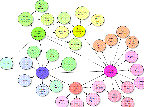
Alternative Categories
"In preparation for Wednesday's Urban Gaming lecture, we thought we'd make a map. We've mapped psychogeography, nomadic communication and technologically infused public space as enablers of the urban gaming explosion. Gaming is the perfect structure for experimenting with these new tools, places and communities. The dynamics between online and offline players, person and space, space and technology, person and technology are being stress tested and observed in the form of games in media labs, art collectives and companies throughout the world. And it's evolving to be a mechanism for social activism as well- so there you go!" From community-centric.
Posted by jo at 01:12 PM | Comments (1)
October 09, 2004
Glowlab
![]()
a hub for public-space arts
Glowlab is a Brooklyn-based arts lab exploring the nature of urban public space. We produce, document and present multi-media work in psychogeography and public-space arts. We organize events, lectures, collaborative projects and exhibitions, and maintain an online lab at www.glowlab.com. Glowlab is particularly interested in the idea of public space as a creative medium, and we offer the Glowlab website as an online studio/playground where artists and the public can connect and learn.
Glowlab is a highly collaborative venture, and we believe the most exciting work develops when multiple viewpoints are explored. The Glowlab community encourages dialogue on issues ranging from the impact of mobile technologies on urban life to the application of open-source concepts in art production. Whether the approach is political, philosophical or artistic, all those involved with Glowlab share a passion for the creative investigation of the urban landscape. Because our work deals specifically with physical space, we offer a number of offline events to bring our community together. In May 2003 Glowlab produced the first annual psy.geo.CONFLUX, a festival and conference in New York dedicated to current artistic and social investigations in psychogeography, held at community art and activist center ABC No Rio. In May 2004, the second annual Conflux took place at PARTICIPANT INC on the Lower East Side. The event grew to include over 50 artists from around the world who engaged in a wide variety of public-space projects, lectures, performances and audio events over the course of four days. Details about the Conflux can be found at: www.psygeocon.org.
Mission
Glowlab supports the evolution of contemporary psychogeography and serves as a hub for public-space arts. Psychogeography is an open and highly experimental discipline concerned with the ways in which the geographic environment affects emotions and behavior. The Situationists first coined the term psychogeography in the 1950s. They explored the city by engaging in “dérives” or observational drifts with the intention of discovering new perspectives on urban life. Current approaches to psychogeography vary, and include artistic, political, philosophical and scientific work in fields ranging from archaeology and cartography to programming, performance and street art. Glowlab is particularly interested in the psychogeographic elements of contemporary public-space art, including performance, documentary work, film/video and urban research. We aim to bring together these diverse perspectives and engage in dialogue on the evolving methods and practice of psychogeography. To that end, we offer both an online community, in the form of the Glowlab website, and an offline presence in the production of a number of projects and events including experimental walks, a monthly salon and a four-day festival in New York.
Posted by jo at 12:55 PM | Comments (0)
September 27, 2004
PsyGeoProvflux
![]()
Investigating Public Space
The PsyGeoProvflux was a two day event investigating how the urban landscape of Providence affects its social and artistic community. Sponsored by PIPS, the Provflux was dedicated to further investigations of contemporary psychogeography and experimental forms of public art. We hoped to create new collaboration between groups and individuals working with and interpreting the urban fabric of Providence. One part conference, and two part experimentation, the Provflux included public space reclamations, maps, 24 hour workshops, and lectures in an effort to discover the unseen in the Renaissance city.
Growing from the efforts of Glowlab in NYC and a larger network of psychogeographers worldwide, the Provflux was initiated after PIPS's participation in the first Conflux in NYC. This year the event has grown, including many more artists and projects deciphering the city in a four day event being held at the same time as the Provflux. We hope the energy generated from both shows can lead to further collaboration between artists and thinkers studying the city.
Posted by jo at 12:55 PM | Comments (1)
August 26, 2004
PING

Presence and Absence
PING, by Kate Armstrong, uses a telephone menu system to distribute active commands to participants who call in using cellular telephones. The choices made by the caller when navigating the telephone system produce directions for physical movement through the city.
PING comes out of psychogeographical inquiry, which focuses on the study of the effects of the environment on the perception, behaviour and mood of individuals. PING is intended to explore the interface between disparate fields such as situationist thought that focuses on subjective mood, generative psychogeography which introduces algorithms as a way to inspire movement through urban space, existentialism, and the interpolation of digital metaphors onto physical, analog space. Read "A Psychogeographical Account of PING and the PsyGeoConflux 2003" by Kate Armstrong.
Posted by jo at 11:08 AM | Comments (0)
